This hearty, flavor-rich dish is well worth the time it takes to prep and cook it. The house fills with fragrant cooking aromas three days in a row as this slow-braised sauce takes shape. The handmade garganelli pasta and Grana Padano cheese are available at Pastaria Deli and wine located within the Clayton restaurant. Photo by Pat Eby
Q • I would love the garganelli recipe with braised beef, olives and Grana Padano from Pastaria in Clayton. I come from a Italian family, and we take pasta seriously. Pastaria is one of my favorite restaurants, if not the favorite. I have had several dishes I love, but the pasta with braised beef is to die for. — Rita
A • This recipe request couldn’t have come at a better time. Cold and wintry weather is the perfect time to make this slow-braised beef and pasta. The process takes three days, but the extra effort and time pays off when this deeply flavorful dish comes to the table.
“At Pastaria, we make this dish starting with 60 pounds of short ribs,” executive chef Brian Moxey says. As he reworked the recipe to an acceptable quantity for home cooks, he didn’t change the process he uses in the Pastaria kitchens, although he realizes it may be challenging.
“I think the steps are important. They pay off in the end with a dish as good as what we make in the restaurant,” he says. “This is something that people wouldn’t normally have time to make. Now they do. What better way to fill your free time right now to making something so comforting?”
Home cooks can even pick up key ingredients curbside at the Clayton restaurant from Pastaria Deli & Wine, like the fresh garganelli pasta and the Grana Padano cheese. The shop also sells a premium aged red wine vinegar, Acetaia San Giacomo.
“We use it in that braise, and I do think it makes a 100% difference in the taste. When we open a fresh bottle of this vinegar at the restaurant it smells so good you want to drink it. Delicious. We absolutely love it,” he says.
As nice as it is to shop ingredients at Pastaria Deli & Wine, Moxey and his crew have put together a great takeout menu as well. In addition to their everyday selections, they will offer a special menu perfect for viewing Super Bowl LV.
“We’re doing a couple fun things with the Deli for Super Bowl. We’re making a Calabrian chile buffalo chicken dip. We also have some really nice artichokes to make a house-made spinach-artichoke dip. We’ll have those available as take ‘n bakes paired with Union Loafers bread,” he says.
“Every Friday, Saturday, Sunday at the deli we’re doing Porano-style pizzas. They have been a big hit, and we’re bringing back a couple of different ingredients, like pizza with pineapple for Super Bowl,” Moxey says.
The dining room at Pastaria is currently open at 25% capacity with full safety precautions in place. Curbside pickup is also available. For Valentine’s Day, Pastaria will feature wine specials as well as a customer favorite. “We’re bringing back Butternut Squash Lasagna with montasio fonduta, maple and brown butter granola, and a Calabrian chili vinaigrette.”
7734 Forsyth Boulevard, Clayton
314-862-6603; pastariastl.com
Would you like to request a recipe from a restaurant that is still open in the St. Louis area? Send your request along with your full name and the city you live in to reciperequest@post-dispatch.com.
45 recipes from some of St. Louis’ favorite restaurants
RECIPE: The Royale's Fish Tacos
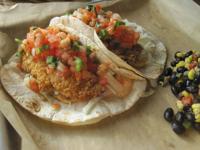
The chefs at The Royale bread fat catfish filets with seasoned crushed tortilla chips, pan fry, then bake them to a crispy finish. Wrapped in a tortilla with a dollop of chipotle mayonnaise, shredded green cabbage, and pico de gallo, the tacos are served with black bean and corn salad.
Yield: 4 servings
2 (8-ounce) catfish fillets
1 cup buttermilk
5 cups round restaurant-style tortilla chips, loosely packed
½ teaspoon ground cumin
½ teaspoon ground black pepper
½ teaspoon salt
2 tablespoons extra virgin olive oil
¼ cup plus 2 tablespoons vegetable oil
8 (6-inch) flour or corn tortillas
Cooking spray
8 to 12 tablespoons chipotle aioli, store bought or homemade
1 cup shredded green cabbage
1 ½ cups pico de gallo, store bought or homemade
Notes: If you don’t have buttermilk on hand, place 1 tablespoon plus 1 ½ teaspoons lemon juice or white vinegar in a 2-cup measuring cup. Fill with milk to the 1 ½ cup line and let stand for five minutes.
• Don’t use baked tortilla chips for this dish; the oiliness of thicker chips sticks better to the fish.
• The Royale uses oil that is a combination of 75% vegetable oil and 25% extra virgin olive oil to pan fry the fillets.
• For the final finish on the fillets, the Royale bakes them directly on the oven rack. You may place a baking sheet under the rack to catch loose crumbs. Alternately, use a rimmed cookie sheet with a cooling rack set on top for the bake. For the test, we used the rimmed cookie sheet.
• The Royale uses flour tortillas for their tacos but you can substitute corn if desired.
1. An hour or two before cooking, cut the fillets in half lengthwise, then cut each piece in half width wise. Rinse under cold water and pat dry.
2. Pour the buttermilk into a shallow bowl and add the fillets. Cover and return to the refrigerator.
3. To make the tortilla chip breading, pulse the tortilla chips in a food processor to crumbs. Add cumin, salt and pepper to the mix and stir to blend. Place 1 ½ cups in a shallow dish big enough to hold a fillet.
4. Preheat the oven to 350 degrees.
5. Remove catfish fillets from the refrigerator. Shake off excess buttermilk and dredge the fillets through the breading on both sides. Add more breading as needed.
6. Preheat an 8-inch stainless steel frying pan over medium-high heat for a minute or two. Mix the olive oil into the vegetable oil and add to the pan. Heat the oil until it begins to shimmer and a drop of water skitters on the surface. Add the fillets and pan fry until the coating turns light brown, about 3 to 4 minutes per side. If the breading does not adhere to the fillets, put the pan-fried fillets back in the dish with the breading and pat in place on both sides.
7. Place finished fillets on a rimmed baking sheet set with a rack and put in the oven to crisp up for about 5 to 7 minutes.
8. Spray a nonstick skillet lightly with cooking spray and add the tortillas to soften.
9. Place a tortilla on the plate and run a line of chipotle mayonnaise down the center. Top with shredded cabbage. Add a catfish fillet and top with 3 tablespoons pico de gallo.
Per serving: 821 calories; 47g fat; 12g saturated fat; 78mg cholesterol; 28g protein; 73g carbohydrate; 8g sugar; 2g fiber; 1,774mg sodium; 221mg calcium
RECIPE: The Fountain Chili Con Chatta
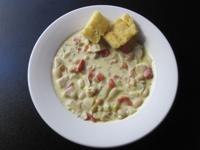
The Chili Con Chatta at The Fountain on Locust features big chunks of chicken, white beans, a smattering of tomatoes, and a kick of mild green chilies in a creamy soup base. It is served with two cornbread croutons.
Yield: 6 servings
2 tablespoons olive oil
1 medium yellow onion, 2 ½- to 3 inches in diameter
½ teaspoon fresh crushed garlic
4 cups low-sodium chicken broth
4 cups low-sodium white beans, drained and rinsed (see note)
1 (4-ounce) can chopped green chilies, mild or hot, according to taste
12 ounces cooked chicken breast
1 (10-ounce) can Rotel tomatoes with green chilies
1 teaspoon ground cumin
1/3 teaspoon black pepper
¾ teaspoon oregano
8 ounces white cheddar, diced
¾ cup sour cream
Notes: For the test, we poached two skinless boneless chicken breasts. You may use rotisserie chicken or leftover baked chicken as well.
• Choose a white bean like Great Northern, navy or cannellini beans. The beans can be cooked from dried beans or use a good brand of canned beans. If using beans cooked from dried, don’t add salt when the beans finish cooking. The cheese is high sodium and will flavor the beans.
• We diced the white cheddar into ¼-inch cubes for the test. To avoid making a stringy cheese soup, don’t bring the soup to a full roiling boil; rather, heat to a slow boil where a bubble breaks the surface every so often, not constantly. Heating the milk mix too high can cause the protein bonds in cheeses to break, release moisture and create a stringy soup.
• The Fountain serves this soup with two small pieces of cornbread, which they call croutons.
1. Warm a 4- or 5-gallon pot over medium heat, then add olive oil and swirl to coat pan.
2. Peel, then chop the onion into ½-inch pieces. Cook over medium heat until translucent.
3. Add chopped garlic to the onions, stir and cook for 1 minute.
4. Add chicken broth, then add beans, cooked chicken, green chilies, Rotel tomatoes, cumin, black pepper and oregano and simmer for 30 minutes.
5. The soup should be hot, but not boiling at this point. Add the diced cheese in 3 or 4 additions, allowing it to melt with minimal stirring.
6. To temper the sour cream, place it in a small bowl. Add about ¼ cup of the hot broth and stir in. Repeat. Add the tempered sour cream to the soup pot and stir in. Serve.
Per serving: 606 calories; 30g fat; 12g saturated fat; 137mg cholesterol; 52g protein; 33g carbohydrate; 4g sugar; 8g fiber; 588mg sodium; 392mg calcium
RECIPE: J’s Pitaria House Salad
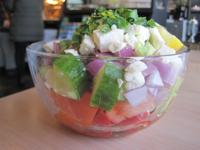
A simple pour of olive oil and squeeze of fresh lemon brings out all the flavors of tomatoes, cucumbers, red peppers, red onion, feta, and parsley in this layered house salad at J’s Pitaria Mediterranean Cuisine in South County.
Yield: 1 large serving (2 smaller servings)
1 medium, ripe Roma tomato
½ large red bell pepper
1/3 of a 10- or 12-inch English cucumber
½ small red onion, 2-inches or less in diameter
¼ cup feta crumbles
1/3 cup of a bunch fresh curly parsley
2 to 3 tablespoons extra virgin olive oil
1/6 of a large lemon, cut lengthwise into a wedge
Notes: This composed, layered salad shows best in a deep clear bowl as seen in the photos.
• It is large enough for two people as a side salad. It can be divided into two bowls easily.
• For the test, the red onion was a bit hot, so we soaked the cut cubes in ice water for 20 minutes to soften the flavor. We then carefully removed the pieces and blotted them dry with a clean dishtowel (or paper towel) before adding to the salad.
• If the lemon isn’t seedless, remove seeds or wrap each wedge in cheesecloth as the lemon is squeezed directly onto the salad.
1. Wash and core, then cut the tomato into 3/8-inch cubed pieces. Place in the bottom of the serving bowl.
2. Cut the bell pepper in half lengthwise, remove seeds and ribs, and then dice into ½-inch square pieces. Cover the chopped tomatoes with pepper pieces.
3. Cut the English cucumber into quarters and then into 3/8-inch pieces. Spread evenly over the peppers.
4. Cut the red onion into chunky pieces, about 3/8-inch. Layer on top of the cucumbers.
5. Scatter the feta cheese over all.
6. Trim the woody stems from the parsley bunch, then finely chop leaves and fine stems. Place a mound in the center of the salad.
7. Drizzle extra virgin olive oil over all.
8. Add the lemon wedge to the bowl and serve.
Per serving (1 large serving): 433 calories; 37g fat; 10g saturated fat; 33mg cholesterol; 9g protein; 22g carbohydrate; 13g sugar; 6g fiber; 366mg sodium; 256mg calcium
RECIPE: Pint Size Chocolate Creme Pie

Pint Size Bakery's Chocolate Creme Pie
Yield: 10 slices
For the pudding pie filling
1 1/2 cups high quality 50- or 60-percent dark chocolate wafers, buttons, or chips (see notes)
2 tablespoons unsalted butter
1 teaspoon pure vanilla extract
2/3 cup granulated sugar, divided
3 tablespoons cornstarch
2 tablespoons cocoa powder
Pinch of kosher salt
2 cups whole milk
1 cup heavy whipping cream, divided
3 egg yolks
1 9-inch pre-baked chocolate pie crust
For the chantilly cream
1 1/2 heavy whipping cream
1/4 cup powdered sugar
1/2 teaspoon pure vanilla extract
Pinch of kosher salt
Notes: Use high-quality dark chocolate wafers or melts in the 50- to 60-percent range from a quality maker. Beyond Food and Guittard melting wafers are available at Whole Foods, while Callebaut wafers can be found at Kitchen Conservatory. Given the state of many pandemic kitchens, we also tested with Ghiardelli 60-percent dark chocolate chips and it does make a nice pudding, but the melts deliver a more even texture, more chocolate flavor and good color.
• The pie filling may be made up to 3 days ahead of time and kept refrigerated. It does not develop a skin.
1. For the pudding: In a medium heatproof bowl combine chocolate wafers, butter and vanilla. Set aside.
2. In a separate heat proof bowl, whisk together 1/3 cup granulated sugar, cornstarch, cocoa powder and salt. Set aside.
3. Add milk, 1/3 cup sugar and 1/2 cup heavy cream to a heavy-bottomed saucepan over medium heat and stir until to dissolve the sugar.
4. Whisk the egg yolks into the dry ingredients (sugar, cornstarch, cocoa powder and salt) and then thin with the remaining 1/2 cup of cream.
5. As the milk mixture begins to simmer, very slowly pour the egg mixture into the pot to temper, whisking as you pour, until fully combined. Stir with a heatproof spatula until the pudding begins to thicken. Boil for 45 seconds to 1 minute. If lumps form, whisk them well before taking the pudding off the heat.
6. Pour the hot pudding into the bowl with the chocolate, butter and vanilla. Let stand for 30 seconds to melt the chocolate, then whisk until the chocolate and butter have melted. Pour filling into a prebaked pie crust, filling it to the brim, and chill for several hours, or up to 3 days, before topping with chantilly cream.
7. If there is extra pudding, fill a dish for the cook.
8. To make the chantilly cream: In the bowl of a stand mixer fitted with a whisk attachment, whip heavy cream, powdered sugar, vanilla extract and salt together until medium peaks form. Don’t overwhip.
9. Spoon cream over pie and chill for 1 hour or up to 2 days before serving.
Per serving: 354 calories; 22g fat; 11g saturated fat; 100mg cholesterol; 5g protein; 37g carbohydrate; 27g sugar; 1g fiber; 186mg sodium; 100mg calcium
RECIPE: Focaccia Bread from Eleven Eleven Mississippi
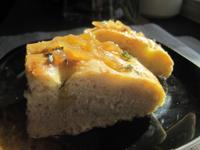
The focaccia at 1111 Mississippi, topped with fresh rosemary, olive oil, and sea salt, is served plated with or without caramelized onions.
Yield: 5 to 6 servings
1 small white onion, about 2 inches in diameter
¼ cup plus 3 tablespoons olive oil (divided)
2 tablespoons balsamic vinegar
2 ¾ cups all-purpose flour plus 1 to 2 tablespoons to flour the board for kneading
1 teaspoon salt
1 teaspoon granulated sugar
1 tablespoon dry yeast
1 teaspoon granulated garlic
1 tablespoon plus 1 teaspoon vegetable oil (divided)
1 cup lukewarm water (no warmer than 110 degrees)
1 tablespoon shortening
Sea salt to taste
1 tablespoon chopped fresh rosemary
Notes: The caramelized onion topping for this focaccia may be made ahead of time, refrigerated and then warmed just before topping the focaccia. The cook time on the onions seems long, but it works well.
• The rise time seems short at 20 minutes, but it worked really well.
• Be sure to deeply dimple the surface of the dough before adding the olive oil. Also, brush the oil out to the sides of the dough. It looks like a lot of oil going over the dough, but it bakes into the dough and gives a nice crisp crust.
1. To make the caramelized onions for the topping, peel and thinly slice the onion into rings and separate them.
2. Heat ¼ cup of olive oil in an 8-inch skillet over low-medium heat. Add onions and cook for 20 to 30 minutes, stirring occasionally, until the onions turn a golden brown color.
3. Remove from heat and stir in balsamic vinegar. Set aside.
4. To make the focaccia, place flour, salt, sugar, yeast and granulated garlic in a large mixing bowl and whisk together.
5. Add lukewarm water plus 1 tablespoon of vegetable oil to the dry ingredients and mix together using dough whisk or a wooden spoon until the dough just pulls together.
6. Turn out the dough on a lightly floured surface and knead until smooth.
7. Lightly oil a large mixing bowl with 1 teaspoon vegetable oil. Place kneaded dough in the bowl, cover with a damp cloth or plastic and let rise for 20 minutes.
8. Preheat the oven to 375 degrees.
9. Punch the dough down. Lightly grease a 10-by-15-inch baking sheet with shortening. Place the dough in the middle and flatten it into a rectangle, 1-inch thick.
10. Use fingertips to poke and deeply dimple the dough all over, pushing all the way down but not through the dough. It will look bumpy.
11. Brush dough with 2 tablespoons olive oil.
12. Bake for 25 to 30 minutes until a light golden brown.
13. Remove from oven and cool on a rack for 10 to 20 minutes.
14. Brush with remaining 1 tablespoon olive oil, spread caramelized onions over the top and sprinkle with chopped rosemary and a pinch of sea salt.
Per serving: 349 calories; 15g fat; 4g saturated fat; no cholesterol; 7g protein; 48g carbohydrate; 2g sugar; 3g fiber; 459mg sodium; 23mg calcium
RECIPE: Dos Reyes Mexican Restaurant Chilaquiles
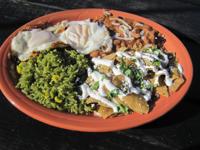
Dos Reyes features chilaquiles to their Mexican breakfast menu. This traditional dish uses day old corn tortillas cut into bite-sized pieces, pan fried to crisp, then cooked in red or green salsa. The chilaquiles are often served with eggs, beans, and rice for breakfast.
Yield: 1 breakfast plate
3 (6-inch) corn tortillas
3 tablespoons vegetable oil
¾ cup salsa verde
1 tablespoon unsalted butter
½ cup pinto beans, warmed
½ cup cilantro rice, warmed
1 ½ tablespoons Mexican crema
1 ½ tablespoons queso fresco Mexican cheese, crumbled
Notes: The corn tortillas for this dish can be a little stale. This is one of the classic uses for day-old tortillas.
• Mexican crema and queso fresco cheese are available at most major supermarkets as well at international and Mexican food stores.
1. Cut the tortillas into random pieces about 1 to 1¼ inches long and wide. They should be bite-sized, cut in triangles and squares.
2. Heat the oil in an 8-inch skillet over medium-high heat until it sizzles. Add the tortilla pieces and allow them to crisp up, turning as needed with a spatula. Seasoned cast iron or nonstick works well for this step.
3. Begin heating a second skillet big enough to cook two eggs sunny side up or over easy.
4. When the pieces have been crisped, add the salsa to the skillet in two additions. There should be a nice coating on the pieces. The salsa should look like dressing on the tortillas.
5. Add butter to the second skillet, allow it to melt and heat through, then break the eggs into the pan and cook either sunny side up or over easy. The egg yolk should be able to run over the dish.
6. Place the warm chilaquiles on a plate. Place warmed pinto beans and cilantro rice on either side. Add the eggs.
7. Drizzle crema over the chilaquiles, then top with crumbled queso fresco.
Per serving: 1,118 calories; 72g fat; 47g saturated fat; 376mg cholesterol; 30g protein; 94g carbohydrate; 8g sugar; 16g fiber; 1,332mg sodium; 252mg calcium
RECIPE: Louie's White Bean Hummus
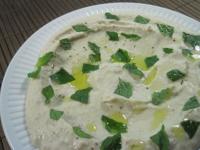
The hummus from Louie DeMun is spread across a plate, topped with fresh mint, smoked salt, and a drizzle of buttery olive oil.
Yield: 6 cups hummus; ½ cup per serving
For the herb sachet that cooks with the beans
1 medium bay leaf
5 whole peppercorns
3 sprigs of fresh thyme, 4- to 5-inches long or 1 ½ teaspoons dried thyme (not ground)
2 cloves fresh garlic, smashed in skins
1 strip of kombu, approximately
1 ½-inches by 4-inches
For the hummus
1 ¾ cups dried Great Northern Beans
7 to 8 cups water to cover beans (4 times their volume)
1/3 cup roasted garlic cloves, squeezed from their skins
½ cup olive oil
¼ cup tahini
5 tablespoons plus 1 teaspoon freshly squeezed lemon juice
1 to 2 teaspoons salt to taste
4 to 5 fresh mint leaves chopped in half inch pieces
1 to 2 tablespoons buttery extra virgin olive oil to drizzle on top
¼ teaspoon smoked salt
Notes: You will find dried kombu, which is a form of seaweed, at Whole Foods and at Global Foods in Kirkwood. The amino acids in kombu help soften beans and makes them more digestible, as well as add a pop of umami to the dish. Nori is not a good substitute for this.
• The day before, roast whole heads of garlic according to your favorite method. Roasting produces a smooth, flavorful and creamy paste that is very mild.
1. The night before, cover the beans with water (4 times the volume of the beans) and soak overnight.
2. Make an herb sachet. Use a double layer of cheesecloth 6-inches-by-6-inches or a small paper coffee filter to hold the herbs. Place the bay leaf, peppercorns, thyme, garlic cloves and kombu strip in the center of the cheesecloth or filter, draw the sachet together to enclose the herbs, then wrap and tie it closed with kitchen twine.
3. Rinse the soaked beans and cover with fresh water to a depth of 2 inches over the beans. Bring the pot to a boil, then reduce heat to a low simmer, add the sachet, cover and vent, and cook beans until tender and soft.
4. Remove the sachet and discard. Drain the beans, reserving 1 cup of cooking liquid to thin out the hummus if needed.
5. Blend the beans in 2 to 3 batches, with proportionate amounts of garlic cloves, olive oil, tahini and half of the lemon juice to an even smoothness, adding reserved cooking liquid as needed.
6. Once everything is smooth, check for consistency of texture throughout and blend as needed.
7. Taste and add half the salt. If more of a lemon flavor is desired, stir in remaining lemon juice. Taste again, then add salt if needed.
8. To serve, spread on a plate, then dot evenly across the top with mint leaf pieces. Sprinkle with pinches of smoked salt. Lightly drizzle with extra virgin olive oil and serve with pita, if desired.
9. Cover and store in the refrigerator for 4 to 5 days.
Per serving: 221 calories; 14g fat; 2g saturated fat; no cholesterol; 7g protein; 20g carbohydrate; 1g sugar; 6g fiber; 250mg sodium; 68mg calcium
RECIPE: Vietnamese Meatballs from Vin de Set (Bánh Patê Sô)
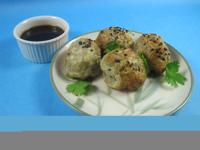
The meatballs blend the complex flavors hoisin sauce, ginger, cilantro, and classic Vietnamese fish sauce to produce a flavorful bite, wrapped in puff pastry and served with a simple soy-ginger dipping sauce. d the pastry.
Yield: 20 large or 40 small meatballs
6 ounces fresh mushrooms, any kind
¼ bunch fresh cilantro (leaves only)
2 tablespoons hoisin sauce
1 ½ teaspoon fish sauce
1 ½ teaspoon ground ginger
1 ½ teaspoon granulated garlic
1 ¼ pound ground pork
2 eggs, divided
½ cup plain breadcrumbs
½ teaspoon salt or to taste
½ teaspoon pepper or to taste
5 sheets Pepperidge Farm frozen puff pastry (it comes 2 sheets to a box)
1 teaspoon cold water
For the dipping sauce
¼ cup soy sauce
¼ cup rice wine vinegar
¼ teaspoon ginger powder
1 ½ teaspoons sweet Thai chili sauce
1 teaspoon toasted black sesame seeds for garnish, optional
1. Preheat oven to 350 degrees.
2. Clean mushrooms with a damp paper towel, trim the stem end and quarter each mushroom.
3. Combine cut mushrooms, cilantro leaves, hoisin, fish sauce, ginger and granulated garlic in the bowl of a food processor and pulse, scraping down the sides, until the mixture resembles medium fine crumbs. It should retain texture and not be a puree.
4. Transfer to a large mixing bowl, then add pork, 1 egg, breadcrumbs, salt and pepper then mix to blend.
5. Portion and shape the meat mix into 20 large or 40 small meatballs. Bake in the oven for 18 minutes for the larger meatballs; 14 minutes for the smaller meatballs.
6. The meatballs may be made a day ahead of time and refrigerated before wrapping.
7. To wrap and bake the meatball, preheat the oven to 400 degrees.
8. Follow the package directions on the puff pastry box for thaw times.
9. Line 2 baking sheets with parchment paper.
10. Mix 1 egg with 1 teaspoon cold water to make the egg wash for the wrapped meatballs.
11. Lightly flour the counter or board before taking out the puff pastry.
12. Using a pizza cutter, cut the pastry down the center lengthwise, then into equal thirds across the pastry. Place a meatball in the center and pull the corners to the center, placing a small amount of egg wash to help seal the pastry. Work the excess dough around to the back for a smooth top and secure with a small amount of egg wash. Place balls smooth side up on prepared sheets, leaving about a half an inch space between them.
13. Repeat with all meatballs, then brush tops and sides lightly with egg wash. Bake for 19 to 22 minutes, checking often. The tops should be nicely browned.
14. While they are baking, make the dipping sauce. Combine soy sauce, rice wine vinegar, ginger powder and chili sauce in a small deep bowl and whisk to blend. Store covered in the refrigerator.
15. Remove meatballs from oven, if desired, sprinkle with black sesame seeds, and serve with dipping sauce.
Alternate method using pastry shells with smaller meatballs: Warm up the meatballs. Place one each in phyllo cups and follow directions to crisp them in the oven. Follow bake times on packages to finish. Top with a sprig of cilantro.
Per serving (based on 20): 141 calories; 9g fat; 3g saturated fat; 39mg cholesterol; 7g protein; 7g carbohydrate; 1g sugar; 1g fiber; 264mg sodium; 15mg calcium
RECIPE: Smoked Old-Fashioned from Bonefish Grill

The Smoked Old Fashioned recipe from Bonefish Grill.
Yield: 1 cocktail
2 ounces of a top-shelf bourbon
½ ounce simple syrup
1 Bordeaux cherry
2 dashes bitters
Notes: Bonefish uses Woodford Reserve bourbon and Angostura bitters for this cocktail
• Bordeaux cherries are Maraschino cherries that are made without artificial ingredients, preservatives or high fructose corn syrup. They are a dark red color with a taste and body similar to Bing cherry. Luxardo cherries are a good substitute if Bordeaux cherries aren’t available.
• The drink is smoked with oak shavings at Bonefish.
• Smoking guns, a specialized tool for smoking food and drinks, are available online and at Williams-Sonoma. Specialized wood shavings are also available when you purchase the gun.
• To smoke the drink without a gun, Bonefish suggests smoking the glass first by torching an oak plank or fresh herbs and capping with rocks glass then pour the drink.
• The drink is served in a rocks glass with a single large cube or ice sphere. If you don’t have the large cubes, use a few smaller cubes.
• Use a snifter to cover the glass and infuse smoke into the drink.
1. Fill a tumbler with ice and pour ingredients over the ice. Using a long handled spoon, stir the drink 10 times, about 30 seconds.
2. Add oak shreds to the smoker and light with a torch to fill the glass with smoke.
3. Cap the glass with a snifter to capture the smoke and allow the oak flavors to mix with the drink.
4. Uncap and serve.
Per cocktail: 168 calories; no fat; no saturated fat; no cholesterol; no protein; 8g carbohydrates; 8g sugar; 1g fiber; no sodium; 1g calcium
RECIPE: Edibles & Essentials Marinated Olives
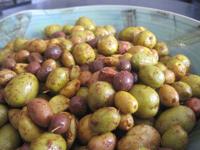
The marinated olives at Edibles & Essentials.
Yield: 4 tapas-style servings
1 pound unpitted mixed olives in brine
1 teaspoon Ras el Hanout
1/2 cup garlic oil
30 medium to large peeled cloves garlic, roasted
Notes: Use a mixture of unpitted large and small Spanish olives in mixed colors of green and black packed in brine. The varieties could include Cacereña, Hojiblanca, Gordal, Manzanilla, Arbenquina, Empeltre and Cuquillo.
• The restaurant roasts the cloves in house by closely arranging 30 cloves in a small ovenproof dish and submerging them in 1 cup of canola oil. Then heat them in a 275-degree oven for 20 to 25 minutes until tender, but still al dente. Next, separate the cloves from the oil, setting aside 1/2 cup of the garlic oil in the next steps of the marinade. (If you are not using the cloves immediately, store in the oil in the refrigerator and use within two weeks.)
• Ras el Hanout spice mix is available online or in international stores.
1. Drain and rinse the olives, spread them out on a sheet or paper towels and let them stand at room temperature for 1 to 2 hours until dry.
2. Place the olives in a mixing bowl and sprinkle with the Ras el Hanout. Turn gently with a wooden spoon or paddle to distribute the spice.
3. Drizzle 1/2 cup of garlic oil (from roasting the garlic) over the olives, add the roasted garlic, mix gently but well. Store in a covered container and refrigerate until ready to use.
Per serving: 193 calories; 12g fat; 2g saturated fat; no cholesterol; 4g protein; 21g carbohydrates; 1g sugar; 5g fiber; 1,422mg sodium; 179mg calcium
RECIPE: Eckert’s Succotash
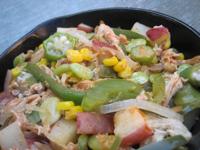
The succotash from Eckert’s Millstadt Farm blends green peppers, onions, lima beans, corn, okra, shredded chicken, and salsa in a dish cooked over an open fire in a giant 48-inch cast iron pan. Angie Eckert modified the recipe for cooks to make at home.
Yield: 6 servings
2 cups potatoes cut in half-inch cubes
¼ cup clarified butter or 4 tablespoons regular unsalted butter (see notes)
1 yellow onion, peeled and sliced in 1/8-inch rings, separated
1 medium green pepper, seeded and sliced in 1/8-inch pieces
1 cup frozen lima beans
½ cup frozen okra
½ cup frozen corn
2 cups chicken, cooked and shredded
½ teaspoon white pepper
½ teaspoon salt
¼ to ½ cup salsa
Notes: Eckert’s uses a commercially available liquid butter for this recipe. Unsalted clarified butter or regular butter, melted, can be substituted.
• Eckert’s cooks this dish in a large cast iron pan over an open fire. The dish can be made on a grill, but we tested it stovetop.
• For this recipe we used red potatoes cut in half-inch cubes, frozen baby lima beans and mild salsa.
• We had all ingredients prepped, measured and ready to add to the pot before we started cooking.
• We used a rotisserie chicken in this dish. After removing skin and bones, we shredded the meat from from 2 thighs and 2 breasts to make 2 cups cooked chicken.
1. Parboil the cut potatoes for 6 minutes, drain and reserve.
2. While the potatoes parboil, preheat an 8- or 9-inch cast iron skillet on low. Raise heat to medium and melt butter in the skillet.
3. Add the onions and spread across the bottom of the pan. Allow to cook for 3 to 4 minutes.
4. Add sliced peppers in an even layer on top of the onions and cook for 3 to 4 minutes.
5. Turn the onions and peppers together, raise the heat to medium high and add the potatoes. Cook for 7 minutes, then turn the potatoes into the onions and peppers and cook for 7 minutes more.
6. Add the frozen lima beans, okra and corn, spreading them evenly over the top of the pan. Cook for 5 minutes, then turn the vegetables into the potatoes, onions and peppers. Add the shredded chicken evenly over the pan and sprinkle with white pepper and salt.
7. Add ¼ cup of the salsa, then turn the chicken into the mix. If needed, add remaining ¼ cup of salsa.
8. Heat until warmed through and serve.
Per serving: 273 calories; 16g fat; 8g saturated fat; 56mg cholesterol; 16g protein; 17g carbohydrates; 5g sugar; 4g fiber; 367g sodium; 35g calcium
RECIPE: Tomato Jam from Rooster
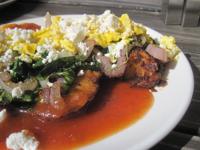
The goat cheese and tomato scramble features silky eggs scrambled with arugula and topped with goat cheese crumbles with sweet and savory tomato jam served alongside.
Yield: 1 quart
1 to 2 tablespoons canola oil
3 pounds Roma tomatoes, core removed, washed, left whole or cut in half lengthwise
¼ cup lime juice
2 tablespoons ground ginger
1/8 teaspoon ground cinnamon
¾ teaspoon ground cloves
1 tablespoon Kosher salt
3 to 4 small to medium size jalapenos, washed, stems removed, and cut in a rough chop
2 cups (1 pound) granulated sugar
Notes: This recipe took three hours to complete during the test. Softening the tomatoes took about 45 minutes, stirring with a wooden paddle every 15 minutes, which left plenty of time to prep and set the rest of the ingredients.
• The tomatoes aren’t peeled for this recipe, but you will need to remove the white core at the stem end of the fruit.
• Slice off a small bite of each jalapenos and taste for its heat level. If the peppers are too hot, remove the seeds and ribs before rough chopping them.
• After adding the sugar, you will need to monitor the jam closely as it needs to be stirred often.
• 220 degrees is the temperature at which the sugar begins to gel and bond with the pectin in the tomatoes. If you don’t have a candy thermometer, take a teaspoon of thickened jam and place on a white saucer. After 30 seconds, push it with the tip of the spoon. If it wrinkles up and holds, it as gelled. If water leaks from under the jam it needs to cook more.
1. Preheat a nonreactive 4- or 5-quart pan over medium low heat. Add the canola oil and swirl to lightly coat.
2. Add the cored Roma tomatoes, stir with a wooden spoon to coat, raise heat to medium high and allow them to cook, stirring occasionally with a wooden spoon.
3. After the tomatoes have softened, add the rest of the ingredients and stir to blend.
4. Bring the mixture to a slow boil, stirring often. Take care as the mixture will pop and splatter. Boil until the jam has thickened and reaches 220 degrees on a digital thermometer.
5. Taste, and then adjust seasoning as needed.
6. Remove from heat, cool and store in the refrigerator in a tightly covered container for up a week.
Per (2 tablespoon) serving: 62 calories; 1g fat; no saturated fat; 95mg cholesterol; 9g protein; 57g carbohydrate; 43g sugar; 4g fiber; 172mg sodium; 240mg calcium
RECIPE: Sicilian Pasta from Rigazzi’s
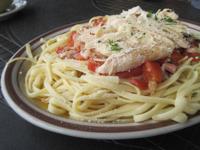
The Sicilian Pasta at Rigazzi’s.
Yield: 4 side servings
½ cup (1 stick) butter
2 to 3 ounces pancetta cut in ¼-inch cubes
1 tablespoon chopped garlic
1/3 cup petite diced tomatoes, drained
4 medium-sized leaves fresh basil, chopped
4 ounces uncooked linguini
3 tablespoons provel cheese, grated or ropes
1 (5-ounce) boneless/skinless grilled or baked chicken breast
3 tablespoons finely grated Parmesan cheese
1 tablespoon finely chopped Italian flat-leaf parsley, leaves only
1. Melt the butter in a large 10-inch skillet over medium-high heat. Add diced pancetta and garlic. Cook 3 to 4 minutes until the pancetta is browned.
2. Add the tomatoes and basil and cook another 3 to 4 minutes.
3. Cook the linguine according to package directions and drain.
4. Plate the pasta. Spoon the sauce evenly over the top. Add the provel, then top with sliced grilled chicken breast, sprinkle Parmesan cheese over all, sprinkle with chopped parsley and serve.
Per serving: 463 calories; 33g fat; 18g saturated fat; 115mg cholesterol; 18g protein; 23g carbohydrate; 2g sugar; 1g fiber; 337mg sodium; 96mg calcium
RECIPE: Eleven Eleven Mississippi Wild Mushrooms With Pecorino Polenta
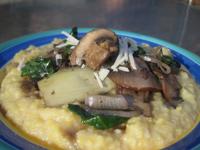
The silky polenta benefits from mellow garlic and from the incorporation of two cheeses – pleasingly sharp Pecorino, a granular cheese made from sheep milk, and from earthy goodness of a little goat cheese.
Yield: 4 to 6 servings
6 cloves garlic, peeled, divided
4 tablespoons extra virgin olive oil, divided
3 to 5 cups low-sodium chicken stock or vegetable stock
½ cup heavy cream or half-and-half, optional
1 cup polenta
¼ cup goat cheese, optional
2 tablespoons unsalted butter
½ cup grated pecorino cheese
Salt and pepper to taste
2 shallots peeled and sliced into thin rings
2 ½ cups assorted mushrooms, sliced
½ cup quartered artichoke hearts in water
1 teaspoon white truffle oil
1 ½ cups roughly chopped fresh spinach
4 tablespoons coarsely shredded Reggiano Parmigiano, optional
Notes: For this recipe, it is best to prep all ingredients ahead of time to keep cooking flowing smoothly.
• For the test we used Bob’s Red Mill Corn Grits Polenta. Grits and polenta vary widely, so the cooking times and the amount of liquid added can also vary widely. Although the test grits reached a nice thick consistency at 5 minutes using the original 3 cups stock and ½ cup half-and-half, tasting a small spoonful revealed a grittiness. We ended up cooking the polenta for 18 minutes total, adding 2 cups more of hot stock in ¼ cup increments as needed, until the mouthfeel was creamy and softly granular. Other quality polentas include locally grown McKaskle Family Farms Organic Popcorn Polenta and Anson Mills Artisan Made Fine Yellow Polenta.
• For the goat cheese, we used a log cut into ½ –inch cubes. Butter was also cut in smaller cubes.
• White truffle oil is available at Extra Virgin, An Olive Ovation in Ladue and at Vom Fass in Maplewood.
1. Finely chop 4 cloves of garlic and set aside. Warm a heavy bottomed 3-quart sauce pan over medium low heat, then add 1 tablespoon olive oil. Reduce heat to low and add the 4 chopped garlic cloves. Stir to coat with oil and sauté for 2 minutes. Do not brown the garlic.
2. Add 3 cups of stock and the ½ cup of cream (optional) to the pot, reserving 2 cups of stock, and bring to a steady simmer over medium high heat.
3. Place the remaining 2 cups stock in a small saucepan on the stove and heat to a steady simmer and keep in reserve to use as needed.
4. Using a whisk, slowly pour the polenta into the 3-quart larger pan, whisking constantly for 5 minutes, until the texture is smooth.
5. Continue to cook, stirring often with a wooden spoon, for 5 to 18 minutes until the polenta thickens to a creamy consistency and loses its hard granular mouthfeel. Add the reserved heated stock as needed in ¼ cup increments.
6. Remove from the heat. Add in the goat cheese and butter and push into the hot polenta with the wooden spoon. Add the grated pecorino in four additions, folding into the hot polenta after each addition. Allow the cheeses to melt before giving a quick stir to incorporate and set aside in a warm spot, such as the back of the stove, cover and vent the pot.
7. Taste, then add salt and pepper if needed.
8. For the topping, finely chop the remaining 2 cloves of peeled garlic. Peel and slice shallots into thin rings and separate. Warm an 8-inch skillet over low heat, raise heat to medium and add remaining 3 tablespoons of olive oil. When the oil is hot, add sliced shallots and garlic and sauté for 1 to 2 minutes without browning them.
9. Stir in sliced mushrooms, chopped spinach, artichoke hearts and truffle oil, and raise heat to medium high and sauté for 5 minutes, stirring often.
11. Taste. Add salt and pepper if needed.
12. Divide the polenta evenly, then top with the sautéed mushroom mixture, garnish with Reggiano Parmigiano (if desired) and serve.
Per serving (based on 4): 534 calories; 35g fat; 15g saturated fat; 59mg cholesterol; 18g protein; 38g carbohydrate; 3g sugar; 4g fiber; 968mg sodium; 183mg calcium
RECIPE: Watermelon Wedge Salad With Melon Balsamic Glaze
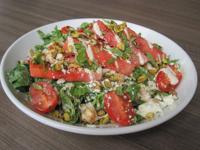
The summertime Watermelon Wedge Salad at Turn features flavors that work well when warm weather hits – watermelon, mint, toasted pistachios, and meaty garbanzo beans. The tahini based salad dressing and melon balsamic glaze drizzled on top brings a nice pop to each bite.
Yield: 4 servings
1 medium seedless watermelon
½ cup granulated sugar
½ cup balsamic vinegar
2 cups tahini
½ cup lemon juice
½ cup white wine vinegar
1 cup pistachio meats
1 cup garbanzo beans
1 pound baby spinach, rinsed and dried
2 to 4 plum tomatoes or 1 pint cherry tomatoes
1 ½ cup feta cheese crumbles
2 cups loosely packed fresh mint leaves, or to taste
Notes: The seedless melon we used for the test was very ripe and the slice in the center didn’t hold its shape, but it still tasted good. The other three slices held the triangle shape.
• The tahini salad dressing makes more than will be used in this recipe. Store leftovers in the refrigerator to use on other fruit dishes and salads. Remove from the refrigerator a few hours before serving to allow it to flow more freely.
• The melon-balsamic glaze shouldn’t be refrigerated.
• Both the dressing and the glaze can be placed in a condiment squeeze bottle with a narrow tip to criss-cross over the salad.
1. Cut the rind off the melon, starting with the top and the bottom, to create a base to work from. Stand the melon on end and remove the remaining rind and white from the sides.
2. Slice half the melon into 4 circles of equal size and set aside for assembling the salad later.
3. To make the juice, cut a slice about an inch thick from the remaining watermelon into small pieces and place in a juicer or blender. You will need 1 cup of juice to make the melon glaze, strained of any seeds. Add more watermelon if necessary. Stop when you reach 1 cup. Strain the juice. There will probably be leftover watermelon from this step.
4. To make the glaze, add the watermelon juice, balsamic vinegar and sugar to a 4-quart saucepan. Place on low heat and reduce until liquid is thick and viscous. Be careful not to burn, stir often and frequently. Also take care to not make caramel. If it cooks too long it will be too thick to drizzle. A good way to tell if glaze is done is by using a wooden spoon. Dip the spoon into the glaze, let cool a bit, drag your finger on the back of the spoon. Your finger should create a clear line on the spoon.
5. To make the tahini vinaigrette, add tahini, lemon juice, white wine vinegar and salt to taste in a blender. Blend until smooth, add water a little at time, if too thick. Note, you will only use a cup and a half of this dressing for the salads. Cover and refrigerate.
6. In a sauté pan dry toast pistachios until toasted brown, careful nut to burn. Rough chop with knife or in the food processor. Do not over process nuts or they will turn to pistachio butter.
7. To assemble the salads, line the bottom of 4 large plates or shallow bowls with spinach. Divide garbanzos and scatter across.
8. Cut each of the reserved watermelon discs into 4 quarters and stack in a line on top of spinach.
9. Slice tomatoes in half if using cherry tomatoes, thin slices if using plum tomatoes, then arrange around the watermelon.
10. Top watermelon with feta and pistachios. Drizzle with tahini vinaigrette, about 3 tablespoons for each plate, and with melon-balsamic glaze, about 2 tablespoons, crisscrossing the salad.
11. Garnish with fresh mint. Use whole leaves or slice the mint in a chiffonade.
Per serving: 1,158 calories; 55g fat; 14g saturated fat; 50mg cholesterol; 38g protein; 152g carbohydrate; 103g sugar; 22g fiber; 832mg sodium; 828mg calcium
RECIPE: The Finkman Cocktail from Onesto

The pleasure of seeing Onesto’s beautiful sipping cocktail The Finkman is rivaled only by its taste – sweet and fruity, balanced and drinkable.
Yield: 1 cocktail
½ ounce blueberry vodka
½ ounce lemon vodka
4 to 6 ounces pineapple juice
1 to 2 ounces pinot noir
Orange slice for garnish
Mint leaves for garnish (optional)
1. Fill a 16-ounce pint glass halfway with ice cubes.
2. Pour both vodkas over the cubes.
3. Fill the glass with the pineapple juice to within a good half-inch from the top.
4. Finish with a slow pour of pinot noir to the top to create the layered effect.
5. Garnish with a slice of fresh orange and a sprig of mint.
Per serving: 211 calories; no fat; no saturated fat; no cholesterol; 1g protein; 31g carbohydrate; 23g sugar; 1g fiber; 5mg sodium; 36mg calcium
RECIPE: Aunt Sally Cookies from Gwin's Tiny Kitchen

A stack of Aunt Sally cookies destined for storage in a vintage Folger's coffee can from Gwin's grandmother Jeanette.
Yield: 24 cookies
For the cookies
¼ cup hot water (not boiling)
1 teaspoon baking soda
3 cups all-purpose flour
¼ teaspoon ground cloves
½ teaspoon nutmeg, freshly grated or ground
½ teaspoon ground allspice
1 teaspoon ground ginger
1 teaspoon ground cinnamon
½ teaspoon salt
½ cup unsalted butter (1 stick), at room temperature
¾ cup granulated sugar
½ cup dark molasses
For the icing
1 ¾ cup powdered sugar
1 ounce plain gelatin (1 packet)
¾ cup cold water
¾ cup granulated sugar
¾ teaspoon vanilla extract
Notes: The cookies may be rolled out to ¼-inch thickness for a crisper cookie or to ½-inch thickness for a softer cookie.
Do not make frosting in advance or it will harden. Make the frosting while the cookies are cooling on the rack.
1. Pour the hot water into a liquid measuring cup, and stir in baking soda to activate it. Set aside.
2. In a large bowl, whisk together the flour, cloves, nutmeg, allspice, ginger, cinnamon and salt. Set aside.
3. In a mixing bowl, using an electric mixer, cream together butter, sugar and molasses for about 8 minutes. Scrape down the sides of the bowl occasionally.
4. Add the baking soda/water mixture to the butter and continue to beat on low. Turn the mixer to medium low and add the flour mixture in 3 additions, beating in one cup at a time.
5. Once dough is well mixed, lay out two strips of plastic wrap and turn out the dough onto one. Use the plastic wrap to move and shape the dough into a disc.
6. Wrap the disc in the second sheet of plastic wrap, then let sit in the refrigerator for 2 hours, or freezer for 45 minutes.
7. Once dough is firm, unwrap it and lay it out on a generously floured surface. Preheat oven to 375 degrees.
8. Flour a rolling pin and roll out dough into 3/8-inch thickness. Cut dough with selected cookie cutter shape. Lay cookies on parchment paper on a cookie cookie sheet.
9. Bake for 6 to 8 minutes.
10. Due to the dark color of the cookies, visual cues of doneness will be based on the top of the cookie. The texture of the cookie will be cracked.
11. Cookies will be soft when pulled from the oven. Allow the cookies to rest on baking sheet for 2 minutes, and then transfer to a cooling rack.
12. To make the frosting, place powdered sugar in a large mixing bowl. Set aside.
13. In small sauce pan, add ¾ cup cold water and sprinkle with gelatin to separate the granules. Let gelatin dissolve. Once dissolved, stir in granulated sugar and cook over medium heat. Simmer the mixture for 10 minutes. After 10 minutes, add the hot mixture to the reserved bowl of powdered sugar. Beat until foamy. Add in the vanilla and beat until thick.
14. Turn the cookie upside down, and frost the flat bottom part. Frosting will be a little runny, but it will firm as it sits. We recommend using a spoon to scoop it on top of cookies, and use the back of the spoon to spread over top. The frosting is meant to be hard, giving you a firm crunchy bite to contrast with the soft texture of the cookie.
15. Do not make frosting in advance or it will harden. Make the frosting while the cookies are cooling on the rack.
Per cookie: 170 calories; 4g fat; 2g saturated fat; 10mg cholesterol; 2g protein; 32g carbohydrate; 20g sugar; 1g fiber; 105 mg sodium; 20mg calcium
RECIPE: Acero Egg Raviolo
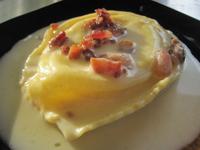
Tender egg raviolo pasta at Acero encases a creamy mixture of ricotta, mascarpone, and Parmigiano-Reggiano cheeses topped with an egg, boiled, and served with a browned butter sauce. Top with crisped bacon, prosciutto, or Italian parsley if desired.
Yield: 6 appetizer servings
2 ¼ cups all-purpose flour
3 whole eggs
¾ cup finely shredded Parmigiano-Reggiano cheese
¾ cup mascarpone cheese
1 ½ cup ricotta cheese
Salt and freshly ground pepper to taste
6 egg yolks
4 tablespoons unsalted butter cut in 9 to 12 slices
Notes: If you haven’t kneaded pasta before, look at a few videos or tutorials to proceed.
• A longer and skinnier wooden rolling pin, lightly floured as needed, worked best for this dough.
• The thickness of the dough determines the cooking time for these ravioli.
• If you don’t want to make fresh pasta, fresh sheet pasta is available pre-made at Midwest Pasta Co. and frozen at DiGregorio’s market. Follow the directions for filling, closing and cooking. These sheets will probably be thicker, requiring a longer cook time.
1. Place the flour in a mound on a clean surface that’s been lightly dusted with flour. Make a well in the center. It should look like a volcano — high and sloped on the sides, deep in the middle.
2. Break the 3 whole eggs into the well and whisk with a fork until well-mixed.
3. Using the fork, gently work the flour into the liquid. Continue until the dough becomes sticky and difficult to work with.
4. Lightly dust your hands with flour, then use them to form the rough dough into a ball.
5. Transfer the dough to a lightly floured surface and knead the dough until it becomes smooth and elastic, about 10 minutes. Cover the dough with a bowl or a clean kitchen towel and let rest 10 to 15 minutes.
6. While the dough rests, stir together the three cheeses in a medium-sized mixing bowl until blended. Taste. Add salt if desired and add freshly ground pepper to taste. Set aside.
7. Turn out the dough onto a lightly floured surface. Using a rolling pin dusted with flour, begin rolling out the dough, turning it as needed, to make a very thin sheet of dough approximately 15- to 18-inches by 12-inches. The dough should be “thin enough to see the knots in a wooden cutting board” — or “thin enough to read a newspaper,” according to Chef Andy Hirstein.
8. Cut the dough into 2 rectangles approximately 15- to 18-inches by 6 inches. Cover one half with a dry towel while you set up the filling.
9. Divide the cheese filling into 6 equal portions. Space them on the uncovered sheet of pasta, 1 to 2 inches apart.
10. Make a well in the center of each mound of cheese and place an egg yolk in the center, taking care not to break the yolk.
11. Using your fingers, lightly wet the remaining dough with your fingers. This is to help seal the raviolo.
12. Carefully place the reserved sheet of dough over the cheese/yolk mounds. Press the top sheet of dough closely around the filling to seal the top sheet to the bottom sheet, removing as much air as possible between the filling and the dough. Removing the air is especially important.
13. Trim the filled dough with a pastry cutter or with a large biscuit or cookie cutter into 6 round ravioli.
14. Bring a 4-quart or 5-quart saucepan of salted water to boil. Carefully slide the ravioli into the water one at a time. Cook for 3 to 6 minutes, depending on the thickness of the dough, until the pieces are al dente.
15. Preheat a stainless steel sauté pan or skillet over medium-high heat, add the butter and swirl it around the hot pan. Cook, swirling often, as the butter crackles and snaps. Remove from heat when the butter begins to smell nutty. It will be brown in color. Pour it into a heat-proof dish.
16. Carefully remove raviolo from water with a slotted spoon. Drain well, plate, and top with brown butter.
Per serving: 707 calories; 47g fat; 29g saturated fat; 398mg cholesterol; 23g protein; 44g carbohydrate; 3g sugar; 1g fiber; 388mg sodium; 401mg calcium
RECIPE: Dos Reyes Chocoflan Cake
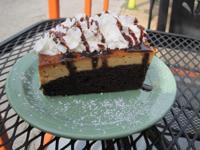
Chocoflan is served topped with whipped cream and a drizzle of chocolate sauce at Dos Reyes.
Yield: 12 servings
11 to 12 tablespoons butter, softened, divided
1/4 cup dulce de leche (cajeta) or thick caramel sauce
1 cup granulated sugar
4 large eggs, at room temperature, divided
1 3/4 cups all-purpose flour, divided
3/4 teaspoon baking powder
3/4 teaspoon baking soda
1/3 cup dark cocoa powder
1 1/4 cup buttermilk
1/4 cup caramel sauce or dulce de leche
1 (12-ounce) can evaporated milk
1 (14-ounce) can sweetened condensed milk
4 ounces regular cream cheese
1 tablespoon pure vanilla extract
Canned whipping cream or regular whipped cream (optional)
Chocolate sauce (optional)
Notes: Allow 20 to 30 minutes for the butter and cream cheese to soften and for the eggs to come to room temperature, depending on the warmth or coolness in the kitchen. When softened, the butter should still be cool to the touch. When gently prodded with a finger, it should leave an imprint. Both steps are important to get the best loft to the cake.
• For the pan release, use butter generously before adding the ingredients. It works better than baking spray for this cake.
• Cajeta, also known as dulce de leche, is available at Mexican grocery stores. A thick caramel sauce will work as well.
• This cake is baked in a water bath. You will need a 9-inch-by-13-inch dish and a roasting pan large enough to fit the baking dish inside.
• This cake bakes into two layers. It looks like the layers mix when added to the pan, but as it bakes the flan settles to the bottom.
1. Preheat oven to 350 degrees, 325 degrees if using a glass pan.
2. Generously grease the bottom and sides of the pan with one to two tablespoons softened butter.
3. Coat the bottom of the pan with caramel sauce. Place the baking pan inside the roasting pan and set aside.
4. Add the remaining 10 tablespoons of butter and sugar to a large mixing bowl. Beat with a hand-held or stand mixer until the mixture is lighter and fluffy. Add one egg and beat it in.
5. Sift flour, cocoa, baking powder and baking soda into a medium bowl and whisk to blend.
6. Add the flour and buttermilk to the creamed butter and sugar, starting with 1/3 of the flour mix and half of the buttermilk. Mix until just blended, then repeat. End with the flour and set aside the cake batter.
7. Bring a kettle of water to boil.
8. To make the flan, add the evaporated milk, condensed milk, softened cream cheese, eggs and vanilla to a blender and blend on high for 30 seconds. Set aside.
9. Place the flour mixture in the prepared pan and smooth it out. Next, pour the flan mixture slowly and evenly over the cake batter.
10. Cover the pan with aluminum foil. Pull out the oven rack and place the roasting pan in the center of the oven. Pour hot water to a depth of 1-inch into the roaster. Push rack in, close door and bake for 50 to 60 minutes, until a toothpick inserted in the cake comes out clean.
11. Carefully remove the cake pan to a cooling rack and allow the cake to thoroughly cool, which will take 45 to 50 minutes. When cooled, place a sheet pan over the cake pan and turn to invert the cake. Scrape any caramel sauce remaining in the pan out and drizzle over cake.
12. Cut into 12 pieces, top with a generous squirt of whipping cream, and criss-cross the whipping cream with a lattice pattern of chocolate sauce.
Per serving: 558 calories; 26g fat; 15g saturated fat; 131mg cholesterol; 13g protein; 71g carbohydrate; 51g sugar; 2g fiber; 282mg sodium; 318mg calcium
RECIPE: Mayo Ketchup's Red Beans and Rice (Habichuelas guisadas)
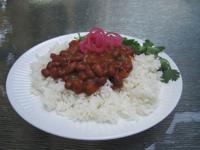
The red beans and rice recipe from Mayo Ketchup works well as a side dish or as a base for bowls savvy cooks can top with pork, steak, chicken, fish, or vegetables.
Yield: 8 side servings
2 tablespoons olive oil
1 cup finely chopped yellow onion
½ cup finely chopped green bell pepper
1 tablespoon minced garlic
2 tablespoons chopped cilantro leaves
1 packet sazon with coriander and annato (see notes)
1 teaspoon dried oregano
½ teaspoon ground cumin
2 cups chicken broth
½ cup tomato sauce
2 (15-ounce) cans small red beans, drained and rinsed
Salt or adobo seasoning to taste
4 cups cooked rice
Notes: Sazon with Coriander and Annato is a premixed spice used in Caribbean cooking. It is available in packets from Goya and in a jar from Badia. The Badia brand blend is Badia Sazon Tropical with Annato and Coriander, which is MSG free. Recipes for a mix-it-yourself version are available online. If mixing your own, use 1½ teaspoons in the recipe. For this test we used the recipe from Skinny Taste.
• Adobe dry seasoning mix is available from Goya as All-purpose Adobo seasoning or from Badia as Adobo Complete Seasoning. For this test we used the recipe from the Spruce Eats to make the spice mix.
1. Preheat a 4-quart pan, then add olive oil and heat over medium high until the oil just shimmers. Add the onions, peppers and garlic and sauté, stirring as needed, until the onions are translucent, 7 to 10 minutes.
2. Lower heat to medium then add cilantro, sazon, oregano and cumin and continue to cook for 2 minutes, stirring constantly.
3. Add broth, tomato sauce and beans and bring to a full boil for 2 to 3 minutes. Reduce heat to a simmer and cook uncovered until desired consistency is reached, about 20 to 30 minutes, stirring as needed. The beans should be stew-like with the onions, green pepper and garlic melting into the sauce. If the beans are too dry, add more liquid. If they are too juicy, cook 5 to 10 more minutes, uncovered.
4. Add adobo seasoning or salt to taste.
5. Serve over steamed rice. The beans may be garnished with avocado slices, springs of cilantro and pickled red onions.
Per serving: 214 calories; 4g fat; 1g saturated fat; 1mg cholesterol; 6g protein; 38g carbohydrate; 2g sugar; 3g fiber; 454mg sodium; 40mg calcium
RECIPE: Clementine’s Lava Cakes

Fudgy lava cakes make the perfect base for a luscious scoop of Clementine’s Madagascar vanilla ice cream topped with hot fudge sauce.
Yield: 8 small cakes
1 cup powdered sugar
¾ cup all-purpose flour
1 cup unsalted butter
1 cup high-quality bittersweet chocolate chips, preferably 69% cacao or higher
2 large eggs at room temperature
1 teaspoon pure vanilla extract
Notes: To bring eggs to room temperature, remove from the refrigerator 20 to 30 minutes before using or immerse the eggs in barely warm water for 10 minutes. With high-fat recipes, adding cold eggs can harden the fats and curdle the batter.
• We used 6-ounce custard cups sprayed with Baker’s Joy pan release. Don’t skip this step, which allows for easy release. We experimented with coating two custard cups first with shortening, then dusted with flour, but the cakes didn’t release very well using this standard method.
1. Preheat oven to 425 degrees. Place oven rack in the middle of the oven.
2. Place powdered sugar in a medium-size bowl. Add flour and whisk to blend, incorporating evenly. Set aside.
3. Place butter in a 2-quart pan and melt over low heat. Add chocolate chips and stir to melt into the chocolate, emulsifying the butter and the chocolate. Turn off the heat and let stand.
4. Break eggs into a medium bowl, add vanilla extract and whisk to blend well.
5. Scrape chocolate and butter mix into the bowl of a stand mixer outfitted with a paddle. If you don’t have a stand mixer, place the mixture in a large mixing bowl and set up a handheld mixer.
6. Beginning with the flour, add 1/3 of the flour to the chocolate and mix on low until just blended. Add 1/3 of the egg mix and mix until just blended. Repeat twice more, always beginning with the flour. After adding the last ingredients, mix until the batter begins to cool to ensure good gluten structure.
7. Spray 8 ramekins, custard cups, or silicone molds with pan-release cooking spray. The size of the baking cup should be 4- or 6-ounces for these cakes. Place the prepared molds onto a baking sheet for ease in handling them in and out of the oven.
8. Place 3 ounces of batter in each cup, which is about 1/3 cup of batter. The easiest way is to use a 3-ounce scoop sprayed with pan release to plop the batter into the prepared molds.
9. Place the filled cups on the baking tray in the middle of the oven and bake, setting the timer for 4 minutes.
10. When the timer sounds, lower the oven temperature to 400 degrees, turn the baking sheet and continue the bake for an additional 3 minutes.
11. Open the door and check the cakes. The top should look mostly dry, but the center may look shinier and have a slight movement. If the entire top is shiny and wet, bake 1 to 2 minutes longer.
12. Remove the tray from the oven and place on a cooling rack.
13. When the cakes are cooled to room temperature, remove from molds, then store in the refrigerator or freezer until ready to use.
14. Reheat cakes in the microwave to just warm before serving. Clementine’s serves them topped with Madagascar vanilla ice cream and hot fudge sauce.
Per serving: 464 calories; 32g fat; 20g saturated fat; 108mg cholesterol; 5g protein; 42g carbohydrate; 31g sugar; 2g fiber; 21mg sodium; 16mg calcium
RECIPE: Mai Lee’s Nuoc Mam Dipping Sauce
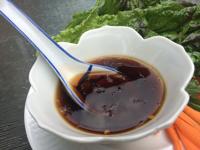
This simple dipping sauce made from the recipe from Mai Lee makes a nice dressing for salads, wraps, and more made at home, as shown here.
Yield: 4 cups sauce
½ cup fish sauce
1 cup granulated sugar
1 cup cold water
1 tablespoon finely minced garlic
1 tablespoon sambal oelek chili sauce
1 ½ cups white vinegar
1 medium juicy lemon or lime, peeled
Notes: Fish sauce and sambal oelek are available at most international food stores. Any fish or chili sauce will do. Mai Lee uses either the Three Cranes Brand or Squid brand of fish sauce and the Huy Fong brand of sambal oelek.
1. Combine the fish sauce, sugar, water, garlic, sambal oelek and vinegar in a medium-sized mixing bowl. Stir to blend.
2. Squeeze the juice from the citrus as well as the pulp into the bowl and stir to blend.
3. Jar and refrigerate.
Per serving (based on 2 tablespoons): 28 calories; no fat; no saturated fat; no cholesterol; 1g protein; 7g carbohydrate; 7g sugar; no fiber; 364mg sodium; 4mg calcium
RECIPE: Akar Blackberry Mint Mocktail

The Blackberry Mint mocktail at Akar can easily be turned into a cocktail, but this recipe Jordan Fisher developed makes a refreshing summer drink the whole family can enjoy.
Yield: 1 serving
3 ounces blackberry mint water (see notes)
¾ ounce honey simple syrup
Ginger beer
Ice (1 large cube, crushed or regular ice cubes)
Sprig of mint leaves for garnish
Notes: To make blackberry mint water, combine 1 cup of cold water with 6 ounces of rinsed fresh blackberries. Place over medium heat and bring to a boil. The berries will release their juice. Remove from the stove, press the berries lightly, then place 3 large mint heads in the palm of one hand then lightly smack them with the other. This step releases the oils in the mint. Add slapped mint to the pot. Allow the berry mint water to cool, then strain and refrigerate until needed.
• Ginger beer is not a fermented drink. It is a carbonated drink classed as a soda with 0 percent alcohol.
• Honey simple syrup and ginger beer are both available at Intoxicology in the Grove.
• To make honey simple syrup at home, mix 2 parts honey to one part very hot water. Stir to blend, then store in a squeeze bottle and use as needed in drinks and salad dressings.
• To make the drink into cocktail, add 1 ½ ounces of gin, vodka, rum or spirit of your choice after step 1 and stir to blend.
1. Add the blackberry mint water and honey simple syrup to a tall glass and stir to mix.
2. Place your choice of a large single ice cube, crushed ice or regular ice in a rocks glass.
3. Slowly pour the blackberry mint water mix over the ice.
4. Float ginger beer to the top of the glass. Stir.
5. Slap the mint (see notes) and garnish the drink.
Per serving: 200 calories; no fat; no saturated fat; no cholesterol; 1g protein; 50g carbohydrate; 46g sugar; 5g fiber; 21mg sodium; 26mg calcium
RECIPE: Pietro’s Fish Sebastian
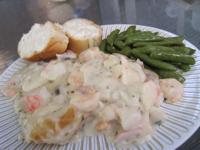
A longtime customer favorite, Fish Sebastian features cod fillets, shrimp, crab, and more in a creamy sauce. The dish comes with two sides plus bread and butter. Sugar snap peas and broccoli are the top two side choices for this dish.
Yield: 4 servings
1 cup heavy cream or half-and-half
3 tablespoons butter
1 cup plus 3 tablespoons all-purpose flour, divided
¼ cup finely grated Parmesan cheese
¼ cup vegetable oil
4 (6-ounce) cod fillets
½ teaspoon salt
½ teaspoon finely ground black pepper
8 ounces lump crabmeat, cooked or canned, or Sea Legs surimi crab substitute
8 ounces cooked shrimp, peeled, deveined and tail removed
8 ounces sliced mushrooms, canned and drained of liquid, or fresh cooked and cooled
½ teaspoon finely chopped garlic
1/3 cup dry white wine
1 tablespoon lemon juice
2 tablespoons fresh parsley, leaves only, chopped (optional)
Notes: For the test, we used the mise en place technique of gathering and measuring all ingredients ahead of time and having them ready on the countertop before cooking begins.
• We bought 12 peeled and deveined shrimp, size 21/30 at the fresh fish counter and had them cooked in-store for this test.
1. To make the white sauce, warm the cream or half-and-half in the microwave or stovetop until just warm, not hot.
2. Melt 3 tablespoons of butter in a heavy-bottomed 2-quart saucepan over medium heat. Do not brown.
3. Gradually sprinkle 3 tablespoons all-purpose flour into the melted butter, whisking constantly. Cook for 4 to 5 minutes and continue whisking to cook off any flour taste.
4. Add a few spoons of the warm milk to the flour-butter mix and stir in. Slowly drizzle in the remaining warm milk, whisking constantly, until the mixture is smooth. Cook, stirring constantly, until it begins to bubble and thicken. Stir in the Parmesan. Reduce heat to lowest setting and keep warm.
5. Warm a large 9- or 10-inch skillet over low heat, then add the oil, raise heat to medium high until the oil shimmers. Flick a drop of water or flour into the skillet to test the heat. It should skitter or sizzle.
6. Season cod fillets with salt and pepper on both sides as the oil heats. Dredge in flour on both sides and place in skillet, allowing room to turn the fillets between each piece. Cook for 3 to 4 minutes, and then flip with a fish spatula or with a spatula with a thin leading edge and cook for an additional 3 to 4 minutes.
7. While the fish cooks, add crabmeat, shrimp, mushrooms, garlic, wine and lemon juice to the cream sauce.
8. Plate one piece of fish on each of 4 plates. Top with 3 shrimp on each piece. Ladle remaining sauce over the plates, evenly divided. Garnish with fresh chopped parsley if desired.
Per serving (using heavy cream): 791 calories; 47g fat; 31g saturated fat; 319mg cholesterol; 66g protein; 28g carbohydrate; 3g sugar; 2g fiber; 1,037mg sodium; 213mg calcium
RECIPE: Summer Breeze Salad from Drake’s Place
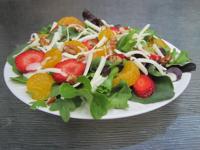
The Summer Breeze salad from Drake’s Place marries the sweet flavors of strawberries and mandarin oranges, a zippy spring mix of baby lettuces and greens, cheeses, and walnuts to create an interesting mélange of flavors and textures.
Yield: 3 large servings
10 cups spring mix to include tender baby lettuce, spinach, arugula, red leaf romaine, frisee, red oak leaf and green mustard mizuna
¼ cup shredded cheese mix of provolone, mozzarella and Parmesan cheese
½ cup sliced strawberries, tops removed, sliced across the berry 3/16 wide
¼ cup well-drained canned mandarin orange pieces
¼ cup roughly chopped walnuts or walnut pieces
6 tablespoons salad dressing of your choice or to taste
Notes: For the test we used Organic Girl Spring Mix augmented with arugula and baby spinach.
• At Drake’s Place, the most popular dressing for this salad, and for any salad served there, is Drake’s Signature House dressing, a creamy dressing with a hint of celery and a pleasantly peppery pop. You can buy Drake’s dressing at the restaurant. The owners are developing it for retail sales. For the test, we used Ken’s Lite Caesar with a little added lemon juice for one serving, and Newman’s Own Raspberry Walnut Vinaigrette for the other. Both dressings worked well.
1. Divide washed and well-dried greens equally on each plate.
2. Scatter with cheese shreds.
3. Place strawberries and mandarin oranges in a pleasing pattern on each place.
4. Sprinkle with walnuts, top with dressing, and serve.
Per serving: 198 calories; 15g fat; 3g saturated fat; 5mg cholesterol; 7g protein; 12g carbohydrate; 6g sugar; 4g fiber; 406mg sodium; 147mg calcium
RECIPE: London Tea Room's Rock Cakes
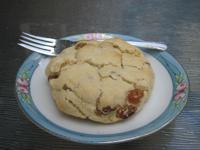
Light, sweet rock cakes studded with sultanas go very well with a cup of The London Tea Room’s house blend, which is similar to an English breakfast tea. Photo by Pat Eby
Yield: 12 cakes
1 cup (2 sticks) unsalted butter, cold
3 cups self-rising flour
Pinch of salt
1 cup plus 2 tablespoons granulated sugar
1 ½ cups golden raisins
1 egg (beaten)
1 tablespoon milk
Butter-flavored baking spray
Notes: This recipe uses self-rising flour. If it is not available in the store, you can make your own by whisking together 1 ½ cups all-purpose flour, 2 ¼ teaspoons baking powder and ¾ teaspoon salt.
• The technique of rubbing the flour and butter together allows the butter to expand encapsulated in flour during baking to produce a lighter cake. You can also pulse the butter and flour together.
• The London Tea Room bakes its cakes in a convection oven at 325 degrees for 20 minutes.
• To keep the raisins from sticking to one another, toss them in a small mixing bowl with a teaspoon of flour, then add to the sugar and toss again.
• If the mixture gets too sticky, add a little more flour and blend.
• Moisten hands with water before shaping the cakes to make the dough easier to handle.
1. Place the oven rack in the center of the oven, and preheat to 350 degrees.
2. Cut the butter into half-inch cubes and place in a mixing bowl.
3. Stir the salt into the flour.
4. Using fingertips only, rub the flour into the butter until the mixture resembles fine breadcrumbs.
5. Mix the sugar and raisins together. Stir the raisins and sugar mix into the flour and butter mixture until just blended.
6. In a separate small bowl, beat the egg with a fork, then add the milk.
7. Add the egg/milk mixture to the dry mix ingredients in a slow pour to mix the dough until blended but not sticky. A dough hook or a large wooden spoon works well for this step. If the mixture has too much liquid the rock cakes will flatten out.
8. Generously spray a baking sheet with butter-flavored baking spray.
9. Next, shape into individual round balls. The tearoom weighs out the balls at 5 ounces each. You can also make smaller cakes by using 3- or 4-ounces of dough. If you make smaller cakes you will need to adjust the baking time down.
10. Place the rock cakes at least 2 inches apart on the prepared baking sheet, place them in the oven and bake for 25 to 35 minutes. Start checking the cakes at 20 minutes, then again at 25 minutes. The bottoms should be very lightly browned. The rock cakes should be a light golden brown appearance on top when done.
11. Remove to a cooling rack and serve warm. Rewarming leftover cakes in the microwave works for this recipe.
Per serving: 334 calories; 16g fat; 10g saturated fat; 56mg cholesterol; 3g protein; 47g carbohydrate; 31g sugar; 1g fiber; 25mg sodium; 22mg calcium
RECIPE: Sister Cities Cajun Garlic Coleslaw
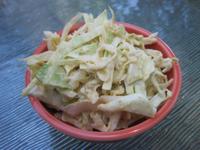
This spicy flavorful Cajun coleslaw may be ordered as a side dish. It is also served on the Cochon Po-boy and with two of the popular tacos at Sister Cities restaurant.
Yield: 16 servings
For the dressing
6 tablespoons milk, 2% or whole
1 tablespoon minced green onion
1 tablespoon chopped parsley, leaves only
½ teaspoon SPG seasoning (see notes)
½ teaspoon dried dill
1 teaspoon fresh dill
1 ½ teaspoons Greek seasoning
¼ cup pickled jalapeno slices (or to taste)
¼ cup creamy hot sauce (or to taste)
½ cup minced garlic
2 tablespoons barbecue sauce
1 tablespoon pepperoncini juice
1 cup plain Greek yogurt
¾ cup mayonnaise
For the slaw
16 cups thinly shredded green cabbage or slaw mix
2 medium carrots, grated (optional)
Notes: SPG is an equal blend of salt, ground pepper and granulated garlic. Do not use garlic powder or garlic salt in the blend.
• This recipe uses a creamy hot sauce. A vinegar-based hot sauce will be too thin to use on this dish. The owners suggest choosing the level of heat in the hot sauce according to personal taste — mild, medium, hot or extra hot.
1. Place all dressing ingredients except mayonnaise and yogurt into blender and pulse to blend well. Add yogurt and mayonnaise and pulse to completely incorporate.
2. Place in a covered jar and store in the refrigerator until ready to mix the slaw.
3. To mix, place shredded cabbage in a large mixing bowl. If you choose, add grated carrot to the cabbage and toss to mix evenly.
4. Add dressing and toss using salad tongs, wooden salad hands or gloved hands. Make sure to evenly coat the cabbage.
5. Cover and refrigerate until time to serve.
Per serving: 135 calories; 9g fat; 2g saturated fat; 7mg cholesterol; 4g protein; 11g carbohydrate; 6g sugar; 3g fiber; 263mg sodium; 76mg calcium
RECIPE: Pickled Beet Salad
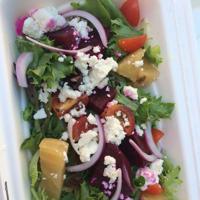
Red and golden pickled beets, cherry tomatoes, red onion, and feta cheese rest on a bed of baby lettuce finished with cider vinaigrette dressing.
Yield: 8 servings
4 medium beets, red, golden or mixed, about 3 inches in diameter
1 1/4 cup plus 2 tablespoons olive oil, divided
1 1/2 tablespoons salt, divided
3 cups apple cider vinegar
2 cups tap water
1 1/2 cups granulated sugar, divided
2 tablespoons pickling spice
1 ½ teaspoons whole fennel seed
1 1/4 cup rice wine vinegar (may substitute cider vinegar if desired)
1 1/4 cup olive oil
1 teaspoon dried oregano
1 teaspoon dried red chili flakes
10 to 12 cups spring mix lettuces torn in bite-size pieced
1/2 medium red onion, about 3 inches in diameter, thinly sliced or shaved across
1 pint grape or cherry tomatoes, halved
4 ounces feta cheese crumbles
Notes: The beets may be roasted and pickled, then refrigerated, a day ahead of time.
• Each color of beet should be kept in separate containers for cooling and pickling to preserve colors.
• Pickled beets are available jarred and ready if time is critical, but they must be fully drained before use.
• Cider vinegar may be used in the dressing instead of rice wine vinegar. Rice wine vinegar should be refrigerated after opening.
• Pickling spice is readily available this time of year and may be found either in the spice section or in the section of the store with canning jars and food preservation supplies.
1. To roast the beets, preheat oven to 350. Trim the beet greens, leaving about 1 1/2 inches of stem on the beets. Do not trim the root. Gently wash beets under cold running water to remove dirt. Don’t scrub or mar the skin. Reserve greens for another use.
2. Brush the beets with 2 tablespoons olive oil, and then sprinkle all beets with 1/2 teaspoon of salt. Wrap each beet in aluminum foil. Place wrapped beets in a roasting pan and cover the pan with foil. Roast for one hour. Check for doneness using a cake tester. When done, the cake tester should push through easily. Add additional baking time if needed until beets are done.
3. Remove from oven and let cool. Remove foil from each beet. Using paper towels, hold each beet by the root and gently rub off the skin and trim the top. Dice into large pieces, about 3/4 inch by 1/2 inch. Place in a large non-reactive mixing bowl (stainless steel or Pyrex) and set aside.
4. To make the pickling brine, place cider vinegar, water, 1 cup sugar, 1 tablespoon salt, and pickling spice in a large 4-quart nonreactive saucepan (stainless steel or Pyrex) and bring to a boil, stirring as needed until the sugar dissolves and the mixture comes to a boil. Pour hot liquid over the diced beets, mix with a spoon, and make sure all beets are covered by liquid. Allow to cool to room temperature before storing, covered, in the refrigerator.
5. To make the fennel dressing, toast the fennel seeds stovetop in a skillet until the seeds are toasty brown and release their fragrance. Remove from skillet and set aside to cool.
6. Place rice wine vinegar, 1/2 cup sugar, and 1 teaspoon salt in blender. Allow to stand for 10 minutes.
7. Next, add 1 1/4 cup olive oil, toasted fennel, oregano and red chili flakes and mix on high speed until the dressing emulsifies.
8. Toss the spring mix, sliced red onions and cherry tomatoes with desired quantity of dressing.
9. Divide dressed greens evenly on 8 plates, and top each with beets and feta cheese.
Per serving: 586 calories; 53g fat; 9g saturated fat; 13mg cholesterol; 33g protein; 25g carbohydrate; 19g sugar; 4g fiber; 1,220mg sodium; 128mg calcium
RECIPE: The Porch Paloma from Tamm Avenue Bar
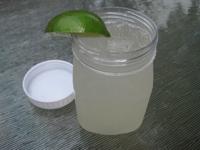
The Porch Paloma, a cocktail-to-go from Tamm Avenue bar, is made for sipping on the porch on warm nights.
Yield: 1 cocktail
Ice to fill a 16-ounce Mason jar, crushed or cubes
4 ounces tequila
Squirt-brand soda
Pinch of sea salt
Notes: These cocktails-to-go are made in 16-ounce Mason jars with a tight-fitting lid for easy transport.
• Ray Edwards prefers the Aguila Tequila Reposado for this drink.
1. Fill a 16-ounce Mason jar to the top with ice.
2. Pour in the tequila.
3. Fill jar with Squirt soda to top of the shoulder.
4. Add a small pinch of sea salt.
5. Screw on lid and shake to blend.
Per serving: 285 calories; no fat; no saturated fat; no cholesterol; no protein; 7g carbohydrate; 6g sugar; no fiber; 162mg sodium; 5mg calcium
RECIPE: Pietro’s Fettuccine Carbonara
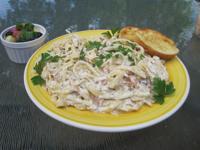
Fettuccine Carbonara from Pietro's.
Yield: 2 very large servings or 4 big side servings
12-ounces cooked fettuccine noodles (about 4 cups)
1 ounce chopped prosciutto (3 to 4 thin slices)
1 ounce chopped bacon (1 strip regular cut, not thick cut)
2 tablespoons unsalted butter
2 cups half-and-half
1 large egg
½ cup finely grated Parmesan cheese
Salt and pepper to taste
1 to 2 tablespoons chopped parsley leaves for garnish
Notes: For the test, we used 6 ounces of dried pasta to get 12-ounces cooked, which measured a little over 4 cups cooked.
• Pietro’s uses Barilla fettucine in their dish. The restaurant cooks it in boiling water for 6 to 8 minutes to the al dente stage. We used the organic fettuccine in the stay-at-home pantry, which was a little narrower than the Barilla noodles. The sauce would work with any long pasta.
• Use a sharp, thin blade — not serrated — to cut the prosciutto and bacon.
• The cream sauce tended to seize up after leftovers spent time in the fridge. Here’s how to reheat them in a nonstick skillet. Heat 1 cup broth or pasta water in a small saucepan. When it comes to a boil, pour half in a warmed nonstick skillet and add the cold noodles, turning to coat them. Cook over medium heat, adding liquid if needed, until the dish is warmed through.
• If you choose to reduce the calories and fat in the recipe, check out Dan Neman’s hints to lighten a creamy pasta dish here.
1. Cook pasta to the al dente stage according to manufacturer’s directions. Reserve 1 to 1 ½-cups pasta water to use to reheat the dish later, or to thin the sauce. Drain and hold the noodles in a warm place as you make the sauce.
2. Crisp both prosciutto and bacon in a large 9- or 10-inch skillet.
3. In a medium bowl, whisk the egg into the half-and-half. Add butter to the skillet holding the prosciutto and bacon and melt, then pour in half-and-half and egg mixture. Bring to a low boil over medium heat and continue to cook for 1 to 2 minutes.
4. Stir in the grated Parmesan, then add the noodles and turn to coat. Serve.
Per serving (based on 4): 351 calories; 15g fat; 8g saturated fat; 82mg cholesterol; 16g protein; 37g carbohydrate; 7g sugar; 2g fiber; 1,023mg sodium; 254mg calcium
RECIPE: LeGrand’s Cheese Tortellini Salad
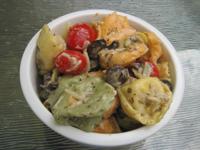
This popular salad at LeGrand’s Market and Deli, available now for carryout or curbside pick up, mixes tricolor cheese tortellini with diced red onions, grape tomatoes, and olives dressed in a cheesy red wine vinaigrette dressing.
Yield: 10 cups salad; 20 small servings
2 pounds 6 ounces frozen tricolor cheese tortellini, cooked according to package directions
½ large red onion, 4- to 5-inches in diameter, peeled and cut in a small dice
½ cup sliced green olives, drained
½ cup sliced black olives, drained
6 to 8 ounces Greek vinaigrette dressing with feta cheese crumbles (see note)
½ cup coarsely shredded Parmesan cheese
1 cup small grape tomatoes
Notes: Store the grape tomatoes at room temperature to preserve top flavor.
• Although this recipe comes together quickly, it needs to chill in the refrigerator before serving, so plan to make it 1 to 3 hours ahead serving time.
• For the test, we used two packages of Luisa’s frozen tricolor tortellini, which cooked to doneness in just 5 minutes.
• We sliced whole black and green olives for this recipe, draining them first.
• The Greek vinaigrette with feta is available from several bottled dressing manufacturers including Wishbone, Girards and Athenos. If desired, add 2 tablespoons feta crumbles to a classic vinaigrette as a substitute.
1. Cook the tortellini according to the manufacturer’s directions, taking care not to overcook them and blow out the shapes.
2. Cool as directed, then place in a large bowl. Toss with diced onion, black sliced olives and green sliced olives.
3. Pour dressing over the salad, ¼ cup at a time, turning gently to coat. Dress to taste.
4. Add shredded Parmesan and toss, then refrigerate, covered, for at least an hour before serving.
5. Just before serving, add the grape tomatoes and toss to coat.
Per serving (based on 10): 398 calories; 13g fat; 6g saturated fat; 51mg cholesterol; 17g protein; 53g carbohydrate; 2g sugar; 3g fiber; 631mg sodium; 250mg calcium
RECIPE: Rick Lewis’ Country Fried Steak
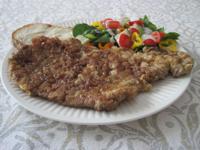
In the covid-19 home kitchen, Rick Lewis’ country fried steak shines with a simple salad and fresh sourdough bread and butter for a stay-at-home lunch. It is traditionally served with pan gravy and mashed potatoes.
Yield: 1 large or 2 small servings
1 (6-ounce) sirloin steak
½ teaspoon salt
½ teaspoon ground black pepper
1 tablespoon very cold water
½ cup all-purpose flour
¾ cups seasoned flour (see notes)
¼ cup plus 2 tablespoons clarified butter
Notes: A meat tenderizer mallet with a textured side and a flat side works best to pound out the steak to the proper thickness. There are several alternative methods to pound the steaks shown in online videos that work without special tools.
• To make the seasoned flour for this recipe, whisk together 1 ¼-cups self-rising flour with ¼ cup plus 2 tablespoons cornstarch, ½ teaspoon black pepper, 3/8 teaspoon white pepper, ¼ teaspoon cayenne pepper, ½ teaspoon granulated garlic, and a pinch of marjoram. Store the leftover seasoned flour in an airtight container in a cool dark place for up to a year.
• Clarified butter has a higher smoke point than regular butter for frying these steaks. It also aids in browning. Directions to make it at home on the stovetop can be found online.
• To pan fry this steak, we used the largest skillet in the house, a nonstick 12-inch professional skillet, that just fit the pounded-out steak. A cast-iron skillet is preferable for this dish, but the nonstick skillet did work.
1. Pound out the steak, beginning in the center of the meat. Use the textured end of the mallet and pound, working out to the edges. Turn it over and repeat, turning each time, until the steak is pounded out to a 1/8-inch thickness and set aside. This step took about 20 minutes to complete.
2. Sprinkle salt and pepper over both sides of the steak.
3. Place the all-purpose flour in a shallow bowl or plate and dredge the pounded pieces, coating both sides. Set aside on a baking sheet or plate.
4. Set up to bread and fry the steak by whisking the egg and cold water together and place in a flat, shallow bowl. Add the seasoned flour to a separate shallow dish.
5. Preheat a large 10- or 12-inch skillet. Add clarified butter and raise heat to medium high.
6. To bread the steak, coat the floured meat on all sides with egg wash, then hold it up to drip off any excess.
7. Dredge the prepared meat through the seasoned flour, coating both sides.
8. Check the heat of the butter by dropping flour in the skillet. It should sizzle when ready but not brown immediately. If it browns, reduce the heat a little. Place the steak in the skillet and fry until the edges start to look golden brown. This step took 4 to 5 minutes in the test. Using a tongs, lift a corner to see that the bottom is nicely browned.
9. Turn the steak carefully with tongs and cook until done to an interior temperature of 150.
10. Removed steak to a plate lined with paper towels to absorb excess grease.
11. Plate and serve. The steak is often is topped with white or brown gravy.
Per serving (based on 2): 735 calories; 41g fat; 24g saturated fat; 235mg cholesterol; 31g protein; 61g carbohydrate; no sugar; 2g fiber; 671mg sodium; 58mg calcium
RECIPE: Nan’s Fried Cauliflower from Nick Lograsso of Onesto
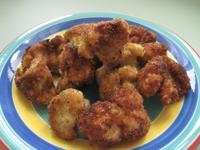
Restaurateur Nick Lograsso had no trouble naming his favorite comfort food, his beloved grandmother’s fried cauliflower tops his list.
Yield: 4 large servings or 8 appetizer servings
1 head cauliflower (approximately 1 ¾ pounds)
1 teaspoon salt
1 tablespoon cold water
2 cups Italian style bread crumbs
1 ¼ cup extra virgin olive oil (or a mix of 50/50 canola and olive oil)
Notes: When you trim the cauliflower, reserve the stem for later use. When its outer fibrous layer is peeled, it can be used in slaws, soups or cauliflower rice or it can be diced and roasted.
• We used half olive oil and half canola oil for the test because the cast iron we used retains heat so well. Canola oil has a higher smoke point than olive oil, so we blended the oils to suit the skillet.
• If you don’t have Italian-style bread crumbs, you can make your own. For 2 cups of plain bread crumbs, add 1 teaspoon dried parsley flakes and garlic powder plus ½ teaspoon each of salt, pepper, dried oregano, basil and onion powder.
• Fry the florets in batches and don’t overcrowd the skillet. For the test, we breaded about 12 pieces as the oil warmed, then dredged and breaded them as needed to keep cooking. It was a little challenging but not that difficult to keep up.
1. Rinse cauliflower under cold water. Pat dry. Remove any large leaves around the base of the stem. Using a paring knife, cut around the stem at the top of the head, rotating the cauliflower as you cut. Break the head into florets, trim large stems if needed and cut extra-large florets into smaller pieces. All pieces should be approximately the same size.
2. Add cold water to a large 3- or 4-quart pot until it is half full, add salt and bring to a fast boil. Add prepared florets and cook for 5 to 6 minutes. Drain and set aside.
3. Set up a space on the counter for the egg wash and the breading. Use a medium bowl for the egg wash and a shallower bowl to hold the breading.
4. Whisk eggs and water in the medium bowl. Add ½ cup breadcrumbs to the shallower bowl.
5. Warm a large skillet or sauté pan over medium-low heat and add oil to a depth of about ½-inch. Raise heat to medium high and heat the oil until hot.
6. As the oil warms, drag florets through the egg wash with one hand. Use the other hand to dredge the florets through the bread crumbs. Make sure each piece is completely coated as some breading will come off in the pan.
7. When the oil sizzles when a flick of flour hits the surface, begin cooking the florets, not crowding the pan, turn as needed and fry until deep golden brown, using short tongs to turn as needed.
8. Remove cooked florets to a dish lined with paper towels and continue frying until all are done.
Per serving (based on 8): 255 calories; 17g fat; 3g saturated fat; 46mg cholesterol; 6g protein; 22g carbohydrate; 3g sugar; 2g fiber; 519mg sodium; 66mg calcium
RECIPE: Yummy Cabbage Sloppy Joes from Paul Whitsitt of Kitchen House Coffee
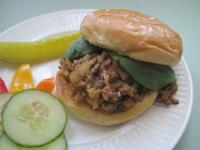
For a lighter, more nutritious take on a meaty sloppy Joe sandwich, try this Yummy Cabbage Sloppy Joe recipe, a favorite comfort food of Paul Whitsitt from Kitchen House Coffee.
Yield: 8 sandwiches
1 pound lean ground beef
½ pounds finely shredded cabbage
1 medium zucchini, shredded or finely diced
1 medium onion, minced
2 celery ribs, chopped
½ cup chopped red pepper
1 cup ketchup
2 tablespoons brown sugar
2 tablespoons lemon juice
1 tablespoon white vinegar
1 tablespoon Worcestershire sauce
1 tablespoon yellow mustard
½ teaspoon salt
¼ teaspoon ground black pepper
8 hamburger buns, or 16 slices of bread, toasted (optional)
Notes: Whitsitt modified the Star recipe to cook the beef and vegetables together at the start of cooking as he likes the flavor better. He uses a turkey baster to lift the fat from the browned ground beef and vegetable mix before adding the sauce. “It’s safer and easier than tipping a full pan.”
• If you don’t have ketchup, you can use a mix of ¾ cup tomato sauce and 2 tablespoons tomato paste, or simply use 1 cup of tomato sauce. The mixture will be a little more watery than ketchup but is lower in calories and carbohydrates.
• Any color bell pepper will work, but red will be the sweetest. For the test we used an orange pepper.
1. Add the meat, cabbage, zucchini, onions, celery and chopped pepper to a preheated large skillet, pan or 5-quart Dutch oven over medium high heat. Chop the beef as it cooks to make crumbles. Cook until the beef is browned and the vegetables softened.
2. Remove the grease with a turkey baster, tipping the pan to collect it.
3. Add ketchup, brown sugar, lemon juice, vinegar, Worcestershire sauce, mustard, salt and pepper to the cooked mixture and stir in. Reduce heat to medium low, cover and cook for 10 minutes until the vegetables are soft, stirring once.
4. Evenly divide, then spoon mixture over toasted buns or bread.
Per serving: 289 calories; 5g fat; 2g saturated fat; 34mg cholesterol; 14g protein; 45g carbohydrate; 17g sugar; 4g fiber; 757mg sodium; 117mg calcium
The recipe was originally developed in 2012 by then 12-year-old Rori Coyne. It was featured in the Kansas City Star in August 2012 after it was chosen by Michelle Obama as a winner in a recipe contest for kids.
RECIPE: Caryn’s Big Bold Chili from Center for Plant-Based Living
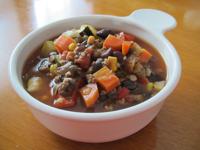
This nutrient dense, bold and flavorful vegan chili doesn’t stint on flavor, texture, or comfort. It is packed with good-for-you vegetables like mushrooms and peppers, plus a healthy addition of bulgur for a meaty bite.
Yield: 16 cups chili; 8 large servings or 16 side servings
1 large sweet onion, approximately 4 inches in diameter
3 garlic cloves, peeled and finely minced
3 cups vegetable broth
1 medium jalapeno, stem cap and seeds removed, cut in 1/8-inch dice
2 large carrots, cut in large dice (if not organic, peel first)
16 ounces of fresh mushrooms of your choice, roughly chopped
1 large green pepper, seeded and cut in a ½-inch dice
2 tablespoons chili powder
2 teaspoons smoked paprika
2 teaspoons ground cumin
1 teaspoon dried oregano
¼ to ½ teaspoon cayenne pepper
1 (28-ounce) can San Marzano whole peeled tomatoes, crushed by hand
1 (14-ounce) can kidney beans, drained and rinsed (or 1 ¾ cups cooked dried beans)
1 (14-ounce) can black beans, drained and rinsed (or 1 ¾ cups cooked dried beans)
1 medium zucchini, cut in a large dice
1 roasted red bell pepper, chopped
½ cup yellow corn (drained before measuring if canned)
2 tablespoons date syrup or maple syrup (see notes)
3 tablespoons tomato paste
1 cup coarse bulgur
Fresh lemon juice (optional)
Notes: You will need a 5-quart or larger Dutch oven or stockpot to cook this recipe at full size.
• For ease in making this dish, chop and measure ingredients in advance.
• San Marzano tomatoes are readily available in St. Louis. They are grown in the Valle de Sarno region of Italy and are known for their flavor, rich texture, low acidity and low ratio of seeds to pulp. If your quarantine pantry doesn’t have them, regular canned whole tomatoes will substitute, but the flavor and texture will be different.
• To make the date syrup, place 5 to 6 pitted dates in a blender and as it is running drizzle in warm water, just enough to form a paste. Alternately, substitute maple syrup for this ingredient.
• Bulgur is available at most grocers. It is a wheat product.
• The cooked chili freezes well.
1. Preheat 5-quart or larger stockpot or Dutch oven. Add onion and stir over medium-high heat until you see the onions begin to caramelize and turn brown, then stir in the garlic, taking care not to let it burn or it will become bitter. If any of the ingredients begin to stick, add vegetable broth 1 or 2 tablespoons at a time.
2. Add in the jalapeno, carrots, mushrooms, green bell pepper and spices. Mix well and cook until the mushrooms release their juices, stirring as needed. This step takes 5 to 10 minutes.
3. Next, hold a whole tomato over the pot and squeeze with your hands to release juices and break tomato into large chunks. Repeat with all tomatoes and then pour in leftover juices. Add kidney beans, black beans, zucchini, roasted red pepper, corn, date syrup (or maple syrup) and tomato paste. Pour in 3 cups vegetable broth. Stir well to blend.
4. Add bulgur and stir well to distribute throughout. Cover, reduce heat to medium low and simmer for 20 minutes or more.
5. To serve, ladle chili into bowls and squeeze a little fresh lemon over each if desired.
Per serving (based on 8): 291 calories; 3g fat; no saturated fat; no cholesterol; 15g protein; 58g carbohydrate; 14g sugar; 15g fiber; 135g calcium
RECIPE: Mama Nordmann’s Home-Style Spaghetti from Tim Nordmann of Mr. Meowski's
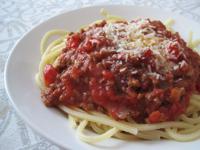
Mama Nordmann’s homemade spaghetti supper was a dinnertime favorite for Tim Nordmann of Mr. Meowski’s Sourdough bakery. The comes together in about an hour. The flavors are bright, uncomplicated, and tasty.
Yield: 8 large servings
1 large yellow onion, 3 inches in diameter
3 to 4 large garlic cloves (to taste)
3 tablespoons olive oil
2 pounds regular ground beef, 70/30 or 80/20 percent lean-to-fat ratio in the grind
2 (28-ounce) cans crushed tomatoes (see notes)
1 6-ounce can tomato paste
1 beef bouillon cube or 3/4 teaspoon beef base
Ground black pepper to taste
2 teaspoons dried basil (or to taste)
2 pounds dried spaghetti
8 tablespoons grated Parmesan cheese
If you don’t have crushed tomatoes, make your own from whole or diced tomatoes. Place the tomatoes in a large mixing bowl. Glove your hands then use them to crush the tomatoes. Canned crushed tomatoes are mixed with tomato paste, so add a can of tomato paste to your homemade crushed tomatoes. This is in addition to the can of tomato paste specified in the recipe.
1. Peel, then cut onion in a 3/8-inch dice.
2. Smash unpeeled garlic clove with the handle or the flat of a knife. Remove peel and roughly chop the cloves.
3. Heat olive oil over medium heat in a 4- or 5-quart heavy-bottomed pot until it just sizzles, and then add chopped onion and sauté for 3 to 4 minutes. Add the chopped garlic and continue to sauté for an additional 2 to 3 minutes.
4. Add ground beef to the onion and garlic mix. Break up the mass of the beef using the leading edge of a spatula or a wooden spoon to small pieces. Cook until the meat is well-browned.
5. Add crushed tomatoes, tomato paste, pepper and basil to the pot and stir to blend. Cover, reduce heat to low, then simmer for an hour, stirring occasionally.
6. Twenty to 30 minutes before the sauce finishes, cook the pasta. Break the spaghetti in half, then cook according to manufacturer’s directions to desired doneness.
7. Drain the spaghetti in a colander and let stand. Spoon a small amount of sauce over the cooked spaghetti and stir in to further “dry” the pasta.
8. Place a serving of spaghetti on each plate, then spoon sauce over the cooked pasta.
9. Top with finely grated Parmesan cheese.
10. Serve with crusty bread and butter.
Per serving: 834 calories; 31g fat; 11g saturated fat; 84mg cholesterol; 39g protein; 99g carbohydrate; 11g sugar; 7g fiber; 481mg sodium; 160mg calcium
RECIPE: Noni Joni’s Creamed Chicken Over Rice from Brendan Kirby of Seed Sprout Spoon
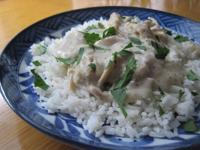
Brendan Kirby’s simple chicken dish is a classic comfort food – warm, creamy, and delicious. It features oven roasted or pulled rotisserie chicken in a white cream sauce served over rice and garnished with parsley.
Yield: 8 servings
1 (3- to 4-pound) roasting chicken or cooked rotisserie chicken
2 teaspoons salt, divided
Pepper to taste
2 cups long grain rice
4 cups water
5 tablespoons unsalted butter, divided
4 tablespoons all-purpose flour
2 cloves garlic
2 cups milk
1/8 teaspoon ground nutmeg (grated)
½ teaspoon celery seed
Juices from roasted chicken, rich chicken stock or soup base
4 tablespoons chopped parsley, leaves only
Notes: Be sure to save the skin, carcass and pan juices from roasted or rotisserie birds to make soup stock.
• You can use white or brown rice for this dish, but the brown rice requires longer cooking times.
• Freshly grated nutmeg delivers the best flavors, but grated will work as well.
• If fresh parsley isn’t available, garnish with dried parsley flakes or with chopped fresh spinach.
• If using a rice cooker or instant pot for this recipe, follow the manufacturer’s directions.
1. To roast the chicken, preheat oven to 450 degrees. Pat chicken dry, inside the cavity and all over the outside, then rub with 1 teaspoon salt and pepper to taste in the cavity and on the outside. Roast for 50 to 60 minutes until the juices run clear and a thermometer inserted in the thigh registers 165 degrees.
2. Remove from the oven and let rest 20 minutes.
3. While the chicken roasts, start the rice.
4. To cook the rice stovetop, place water, 1 teaspoon salt and 1 tablespoon butter in a 3-quart saucepan with a tight-fitting lid. Bring the water to a boil, then stir in the rice. Reduce heat to low, cover and simmer for 20 minutes over low heat. When done, fluff the rice with a fork.
5. While the rice cooks, start the sauce.
6. Melt remaining 4 tablespoons butter in a skillet or saucepan over medium-low heat. Smash the garlic with the back of your knife. Remove and discard papery skin and end of clove. Rough chop and add to the butter, reduce heat to low, and cook for 10 minutes to soften, but not brown, the garlic.
7. Sprinkle the flour over the melted butter and garlic, raise heat to medium and whisk the flour into the butter for about 1 minute until the flour incorporates smoothly with no flour lumps.
8. Add pepper to taste, and then add celery seed and grated nutmeg. Stir to incorporate.
9. Slowly pour the milk into the pan while whisking constantly, making sure to whisk the sides of the pan as well. Turn the heat to low and whisk often for 5 to 10 minutes. The sauce will thicken as it simmers.
10. Add a tablespoon or more of pan drippings, whisking to incorporate, to add more flavor to the sauce, until the sauce reaches the proper consistency.
11. Pull the meat from the roasted chicken and chop to bite-sized pieces when needed.
12. Serve the chicken over rice and garnish with parsley.
Per serving: 638 calories; 33g fat; 12g saturated fat; 148mg cholesterol; 38g protein; 44g carbohydrate; 3g sugar; 1g fiber; 947mg sodium; 120mg calcium
RECIPE: Piccione’s Orange Pistachio Shortbread Cookies from Butler’s Pantry Boardroom

Buttery shortbread cookies studded with pistachios and flavored with orange zest and orange glaze from Laura Dignon at Butler’s Boardroom are easy to make and a comfort to eat.
Yield: 42 cookies
2 cups shelled pistachios, roughly chopped
1 pound unsalted butter, softened
1 cup granulated sugar
2 teaspoons vanilla extract
Zest of 2 oranges
3 ½ cups all-purpose flour
½ cup cornstarch
Pinch of salt
1 ½ cups powdered sugar
1 tablespoon orange juice
Notes: The butter for this recipe should be softened to the point where a finger pushed into the butter leaves an indentation but does not collapse.
• The pistachios should be roughly chopped rather than finely chopped. Chopping pistachios produces fine dust. Prior to toasting them, we tossed the chopped nuts in a fine mesh strainer to dislodge the fine dust.
• The logs can be wrapped well and frozen in freezer-safe packaging to slice and bake at a later date.
1. Toast pistachios in the oven or stovetop in a skillet for 6 minutes. Set aside to cool.
2. In a large mixing bowl, cream butter and granulated sugar together until light and fluffy, then add the vanilla and orange zest.
3. In a separate bowl, whisk flour, cornstarch and salt together.
4. Add flour mixture to the butter mixture in three or four additions, scraping down the bowl in between. Just before the last addition is fully combined, add chopped pistachios. Avoid adding any extra pistachio dust. Mix until just combined.
5. Turn the dough out onto a floured surface and knead a few times to make sure all ingredients are combined.
6. Divide the dough in 2 pieces. Roll into logs 2 inches in diameter. Wrap the logs and refrigerate for at least an hour.
7. Preheat oven to 350 degrees about 10 minutes before removing the dough logs from the refrigerator.
8. Slice the dough into generous ¼-inch thick slices and place on an ungreased baking sheet. Bake for 10 minutes total, rotating the baking sheet halfway through. The cookies are done when the edges are lightly golden.
9. Remove baked cookies to a wire rack to cool.
10. While the cookies cool, make the glaze. Whisk together orange juice and powdered sugar. The glaze should be just liquid enough to stream off the end of a whisk. Add more orange juice if needed in small increments.
11. Drizzle cookies with glaze and let dry.
Per cookie: 190 calories; 12g fat; 6g saturated fat; 24mg cholesterol; 2g protein; 20g carbohydrate; 10g sugar; 1g fiber; 5mg sodium; 11mg calcium
RECIPE: Bravo! Cucina Crispy Shrimp Napoli

The flavors and colors of Italy shine in the Crispy Shrimp Napoli at Bravo Cucina with its delightfully complex red charred tomato sauce, delicately coated butterfly shrimp, and bright green sliced onions.
Yield: Serves 8 as a shared appetizer
1 pound peeled and deveined shrimp, size 16-20 per pound, tails removed and bodies butterflied
1 cup buttermilk
2 mild banana peppers
¼ cup plus 1 tablespoon extra virgin olive oil (divided)
1 (10-ounce) can fire-roasted tomatoes, well-drained
1 teaspoon smoked paprika
1 ½ teaspoons kosher salt (divided)
1 teaspoon black pepper (divided)
2 tablespoons red wine vinegar
2 tablespoons plus 1 teaspoon honey
Vegetable oil or vegetable-canola oil blend in quantity recommended by manufacturer of fryer
1 cup rice flour
½ cup Wondra flour or substitute (see notes)
½ cup heavy whipping cream or half-and-half
¼ cup unsalted butter cut in ½-inch cubes
Juice of 1 medium lemon, strained of seeds
2 to 3 green onions, green part only, sliced on the diagonal
¼ cup plus 2 tablespoons grated Parmesan cheese
Notes: Find Wondra flour online at Amazon.com or make a substitute: In a small bowl, whisk together 1 cup of bleached all-purpose flour with 1 teaspoon of cornstarch. Use a sieve or a triple flour sifter to sift the mix three times. Store in a covered container.
• If cooks don’t want to deep fry or pan fry the shrimp, it still works if you saute the shrimp.
• This dish is not served hot, but more at room temperature.
• The leftovers can be used with pasta for a nice second round. Note that the shrimp loses its crispy texture after refrigeration but still tastes great.
1. Eight to 24 hours before cooking the dish, place shrimp that has been peeled, deveined, tails removed and butterflied in a large shallow dish like an nonreactive 8- or 9-inch gratin pan or cake pan. Pour buttermilk over the shrimp and marinate, covered, in the refrigerator until cook time.
2. The following day, wash the mild banana peppers and toss with 1 tablespoon of olive oil to coat. Char over an open flame on a gas stove or grill or in a grill pan until the skin blackens and blisters. Place blistered peppers in a bowl and cover with plastic or in a paper bag to steam for 10 minutes.
3. Pour canned fire-roasted tomatoes and juices into a mesh strainer over a bowl. Allow tomatoes to stand at least 10 minutes. Press tomatoes lightly with a spoon to release juices. Place well-drained tomatoes in a small stainless steel bowl, cover loosely and set aside. Save juices for a future cooking project if desired.
4. Remove the skin from charred peppers. Cut them in a 1/8-dice and add to tomatoes.
5. Stir smoked paprika, ½ teaspoon kosher salt and ½ teaspoon black pepper into the tomatoes.
6. Add ¼ cup olive oil, red wine vinegar and honey. Stir to blend, then add to the tomato sauce and set aside. This sauce is not cooked.
7. Begin heating recommended amount of oil in home deep fryer to 375 degrees.
8. Warm a small shallow sauce pan over low heat, then add heavy cream or half-and-half. Add butter cubes one or two at a time to melt. Don’t allow the sauce to bubble or boil, but just to stay warm enough to melt butter. As the sauce heats, juice one lemon into a small bowl.
9. Remove the pan from the heat. Add a little of the warm sauce to the lemon juice and stir to temper. Stir tempered lemon juice into the warm butter and cream. Cover and set to a warm place on the counter.
10. In a small bowl, whisk together rice flour, Wondra or substitute, ½ teaspoon each kosher salt and ground black pepper.
11. Remove shrimp from the refrigerator. Toss them in the pan to coat. If necessary, add more buttermilk to moisten shrimp.
12. Ladle flour mixture over the shrimp and toss to coat them evenly, making sure all sides are coated. Line a rimmed cookie sheet with brown paper bags or paper towels; this will be used to drain cooked shrimp.
13. When the oil is ready, fry in batches until golden brown and crispy. Removed to rimmed sheet to drain.
14. To plate the dish, add ¼ cup shredded Parmesan to the tomato sauce blend. Measure out 2/3 cup of tomato sauce and ½ cup of lemon cream and butter sauce into a small bowl. Stir together to just blend.
15. Place 3 tablespoons each of the blended sauce on two serving platters and spread around.
16. Place half the shrimp on each plate over the sauce. Top with remaining sauce divided between two platters. Sprinkle lightly with green onions and remaining Parmesan cheese.
Per serving: 478 calories; 33g fat; 19g saturated fat; 118mg cholesterol; 15g protein; 32g carbohydrate; 7g sugar; 2g fiber; 665mg sodium; 117mg calcium
RECIPE: Pietro’s Italian Poor Boy Sauce
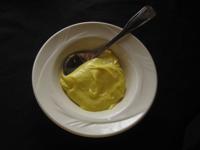
The lively sauce featured in Pietro’s Italian sub sandwich is easy to make. It would work well on many sandwiches, plus it lends itself to variations in the ingredients to change its flavor profile and kick up the flavors of different meats and cheeses.
Yield: 1 cup of sauce; 8 to 10 servings
¾ cup plus 2 tablespoons good quality mayonnaise
2 tablespoons classic yellow mustard
Notes: Classic yellow mustard adds a little zing. Pietro’s uses French’s or Heinz as the yellow mustard base.
• Choose a good-quality mayonnaise like Duke’s or Hellman’s for this. Pietro’s uses a brand only available to restaurants.
1. Place mayonnaise and mustard in a small deep bowl and stir to blend. Make sure the mustard is totally incorporated into the mayonnaise.
2. Cover, then refrigerate any leftovers and use within 2 weeks.
Per serving (based on 8): 172 calories; 19g fat; 3g saturated fat; 10mg cholesterol; 1g protein; 1g carbohydrate; no sugar; no fiber; 153mg sodium; 6mg calcium
RECIPE: The Fortune Teller Bar Glühwein

The Fortune Teller Bar serves this traditional German drink throughout the cold winter months in St. Louis. Fragrant with spices and redolent of oranges, Glühwein warms both hands and hearts.
Yield: 8 to 10 servings
1 750 ml bottle of dry red wine
1/4 cup Cognac or brandy
1/4 cup orange Curaçao or triple sec
1/4 cup brown sugar, lightly packed
1 stick cinnamon
1 teaspoon whole allspice berries
3 whole cloves
Orange slice or twist of rind for garnish
Notes: The bright taste and clear color of this warm mulled wine comes from steeping the spices 8 hours in the liquids before warming it.
1. Mix the alcohol together with the brown sugar in a large nonreactive container and stir to blend.
2. Break the cinnamon stick into small pieces. Place cinnamon, allspice berries and cloves in a large tea ball. Drop the packaged spices into the liquid mixture, cover and refrigerate for 8 hours.
3. Remove tea ball. Transfer the spiced liquids to a crock pot set on warm.
4. If a crock pot is not an option, warm over medium heat in a nonreactive pan until the liquid is steaming. Do not boil.
5. Ladle into small mugs or tempered punch bowl glasses. Garnish with orange slices or with a twist of orange peel.
Per serving (based on 10): 114 calories; no fat; no saturated fat; no cholesterol; no protein; 11g carbohydrate; 7g sugar; 1g fiber; 5mg sodium; 17mg calcium
RECIPE: Eleven Eleven Caramelized Brussels Sprouts
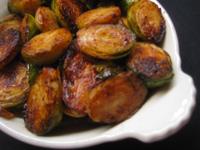
Customers love the caramelized Brussels sprouts At Eleven Eleven Mississippi. The dish is the number one side order on the Tuscan and Californian inspired menu.
Yield: 4 to 6 servings
16 Brussels sprouts, washed, trimmed and cut in half lengthwise
2 tablespoons extra-virgin olive oil
2 to 3 tablespoons vegetable or chicken stock
1 tablespoon white balsamic vinegar
Kosher salt and ground pepper to taste
Notes: For the test, we chose 16 medium-sized sprouts, which weighed just under one pound. The sprouts should be of similar size to cook evenly.
• Eleven Eleven uses vegetable stock for this dish in the restaurant.
• White balsamic vinegar is available in most grocery stores. It adds a nice fruity flavor without muddying the color of the sprouts.
• When adding the stock, start with 2 tablespoons and add more only if needed. For the test, we used an electric stove with the burner on medium-high. Even though the heat was turned down to low, the burner stayed hot and the stock evaporated immediately, so we added another tablespoon.
1. Wash, then trim the stem ends from the sprouts. Remove loose or discolored leaves. Lightly pat dry with a towel. Cut the sprouts in half lengthwise and set aside.
2. Heat a large 8- or 9-inch skillet or saute pan over medium-high heat. When the pan warms, add olive oil, then add the prepared Brussels sprouts.
3. Saute until the sprouts are well-caramelized on all sides, stirring just a few times. This step takes from 5 to 10 minutes. The Brussels sprouts will begin to turn color as they cook and become fragrant.
4. Reduce the heat to a low, add 2 tablespoons of stock, and simmer until all of the liquid evaporates. If the liquid evaporates too quickly, add 1 tablespoon more and cook until it is gone.
5. Pour the balsamic vinegar around the pan. Stir, then season with kosher salt and pepper.
6. Taste, and adjust seasonings if needed.
7. Serve immediately.
Per serving (based on 4): 99 calories; 7g fat; 1g saturated fat; no cholesterol; 3g protein; 8g carbohydrate; 2g sugar; 3g fiber; 612mg sodium; 34mg calcium
RECIPE: Union Loafers Little Gem Salad
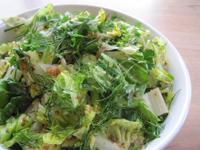
The Little Gem salad at Union Loafers pairs hearts of romaine lettuce with butter lettuce, fresh herbs, toasted bread crumbs, and pickled shallots in a creamy buttermilk dressing.
Yield: 6 large salads
9 shallots, divided
1 1/3 cups distilled white vinegar
1/3 cup granulated sugar
1 1/3 cups water
2 teaspoons kosher salt, divided
1 small clove garlic
¼ cup plus 2 tablespoons buttermilk
¼ cup sour cream
2 pasteurized egg yolks
1 tablespoon lemon juice
1¼ cups canola oil
1 teaspoon olive oil
3 tablespoons panko bread crumbs
5 heads bibb or other lettuce, rinsed well and dried, then torn in bite-sized pieces
2 heart of romaine, rinsed well and dried, chopped in pieces about 1¾-inches squares
¼ cup plus 2 tablespoons chopped chervil
¼ cup plus 2 tablespoons chopped chives
¼ cup plus 2 tablespoons chopped dill
¼ cup plus 2 tablespoons chopped Italian flat-leaf parsley
Notes: The pickled shallots must be made a day ahead. The shallots will keep in the refrigerator in a covered container for a month.
• The lettuces should be spun dry or towel dried for best results. Union Loafers spins the lettuces dry, then pats with paper towels if needed.
• If fresh chervil is unavailable, substitute smaller, curly parsley leaves.
• Union Loafers makes toasted bread crumbs from scratch, but toasted panko works well for this salad.
1. The day before, peel and thinly slice 8 shallots crosswise, using a mandoline or a sharp knife. Separate into rings. Place sliced shallots in a colander, rinse with cold water, and let drain. Place in a tempered glass bowl or other nonreactive bowl and set aside.
2. Combine vinegar, sugar, water and 1 teaspoon kosher salt in a 2-quart pan. Heat to boiling over medium-high heat, stirring occasionally, until the sugar dissolves and the liquid is clear.
3. Pour hot liquid over the prepared shallots and let cool to room temperature. Cover and refrigerate overnight.
4. To make the dressing, peel and roughly chop the remaining shallot. Place it in a blender then add the garlic clove, buttermilk, sour cream, egg yolks, lemon juice and remaining teaspoon of salt. Blend on high for 20 to 30 seconds.
5. Reduce blender speed to medium and stream canola oil in until the dressing is emulsified.
6. The dressing should be used within 2 days if made with regular egg yolks; within 5 days if using pasteurized eggs.
7. To pan toast the panko, wipe a 6-inch skillet with olive oil and heat over medium high until the skillet is hot. Add panko and stir until the flakes brown.
8. To assemble the salads, toss the torn bibb lettuce with the chopped romaine in a large mixing bowl. Drizzle with 1 cup of buttermilk dressing and toss to coat evenly. Add toasted panko crumbs and 1/3 cup pickled shallots, drained, and toss to distribute.
9. Place half the lettuce mixture into each of 6 large salad bowls. Divide the chopped herbs in half. Sprinkle one half over the bottom lettuce layer.
10. Add remaining lettuce to the bowl and place remaining chopped herbs. Serve immediately.
Per serving: 660 calories; 52g fat; 5g saturated fat; 66mg cholesterol; 13g protein; 46g carbohydrate; 24g sugar; 17g fiber; 742mg sodium; 297mg calcium
RECIPE: Stellar Hog Quinoa and Chickpea Veggie Burger
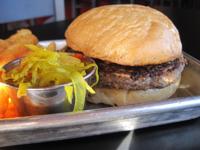
The meatless burger at The Stellar Hog doesn’t rely on black beans, but uses a unique combination of chickpeas, quinoa, and chia seeds to create this vegan burger.
Yield: 6 large patties
1 tablespoon chia seeds, ground
¾ cup water tepid water
4 to 6 tablespoons olive oil, divided
1 medium red onion, cut in an 1/8-inch dice, about 1 1/3 to 1 ½ cups total
1 cremini mushroom, cut in an 1/8-inch dice
1 tablespoon plus ½ teaspoon salt, divided
1 ½ cup cooked chickpeas, roughly but evenly chopped
1 tablespoon soy sauce
1 tablespoon apple cider vinegar
1 tablespoon real maple syrup (don’t use a maple syrup substitute)
1 ½ cups cooked quinoa, cooled
½ cup rolled oats (not instant)
2 garlic cloves, peeled, crushed, then minced fine
½ teaspoon allspice
½ teaspoon cinnamon
Notes: Grinding the chia seeds is important to the success of the recipe. The ground seeds quickly develop into a mucilaginous gel that helps hold the burgers together. Use a spice grinder or coffee grinder to do this.
• Use a blender to grind the rolled oats into a coarse meal.
• Don’t use a food processor to chop the onion and mushroom. It releases too much water. The 1/8-inch dice cut is called brunoise, and there are instructions and tutorials online that show good technique for this.
• The chickpeas shouldn’t be ground smooth but should have some texture and be similar in size. For the test, we used a small food processor and made two passes, separating out the larger pieces after the first run and processing them a second time to maintain similar size.
• The patties may need more ground oats if the mix is too watery after the 10-minute rest after the first knead.
1. Grind the chia seeds fine in a spice or coffee grinder, then place in a small bowl and add ¾ cup water. Set aside.
2. Heat 2 tablespoons olive oil in an 8-inch skillet over medium heat until it just shimmers. Add finely diced onions and mushrooms. Stir in ½ teaspoon salt and saute the mixture over medium-high heat, stirring occasionally, until the onion is translucent. Set aside to cool.
3. Roughly chop chickpeas with soy sauce, vinegar and maple syrup to an even texture.
4. Grind the rolled oats in a blender to the consistency of coarse meal.
5. In a medium mixing bowl, combine quinoa, chia seeds, sauteed onions and mushrooms, chopped chickpeas, ground rolled oats, minced garlic, allspice and cinnamon.
6. Knead mixture together with 1 tablespoon salt. Let mixture rest for 10 minutes.
7. Knead again to blend. If the patties are too loose, add more ground oats.
8. Form into 6 large patties, using about ¾ cup of the mixture.
9. Add 2 tablespoons olive oil to an 8-inch warmed skillet or saute pan and heat over medium high heat until the oil shimmers and skitters when flicked with a drop of water. Add patties and cook for about 5 to 6 minutes per side for a good hard sear.
10. Serve on a toasted bun. Top with any burger toppings.
Per serving: 367 calories; 18g fat; 3g saturated fat; no cholesterol; 10g protein; 43g carbohydrate; 7g sugar; 8g fiber; 967mg sodium; 83mg calcium
RECIPE: Arugula Pesto from Rooster
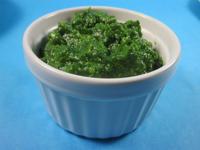
The pesto can be used in many ways at home. In addition to mixing it in with hot pastas, cooks can make a salad dressing, a dip for vegetables, or use it mixed with goat cheese and plain yogurt to top crostini.
Yield: 4 cups
4 cups arugula, rinsed and spun dry, packed
1 tablespoon minced garlic
2 tablespoons kosher salt
1 cup canola oil
½ cup grated Asiago cheese
Notes: For the garlic, you can use fresh cloves minced or use jarred minced garlic packed in oil. For the test, we used the jarred garlic.
• Canola oil or olive oil may be used for this recipe, but the canola oil has a more neutral taste.
• The Asiago cheese should be finely grated so it blends into the pasta well.
• A blender or a food processor will work to make this recipe. Divide the quantities if needed, process and then mix together at the end.
1. Place all ingredients in a food processor or blender and pulse until smooth.
2. Keep in the refrigerator, tightly covered, for up to a week.
Per (2 tablespoon) serving: 66 calories; 7g fat; 1g saturated fat; 1mg cholesterol; 1g protein; 1g carbohydrate; 1g sugar; no fiber; 254mg sodium; 20mg calcium
February 03, 2021 at 02:55AM
https://ift.tt/3pMNmoM
Pastaria's slow-braised beef pasta dish is perfect comfort food - STLtoday.com
https://ift.tt/31oM9uv
Pasta
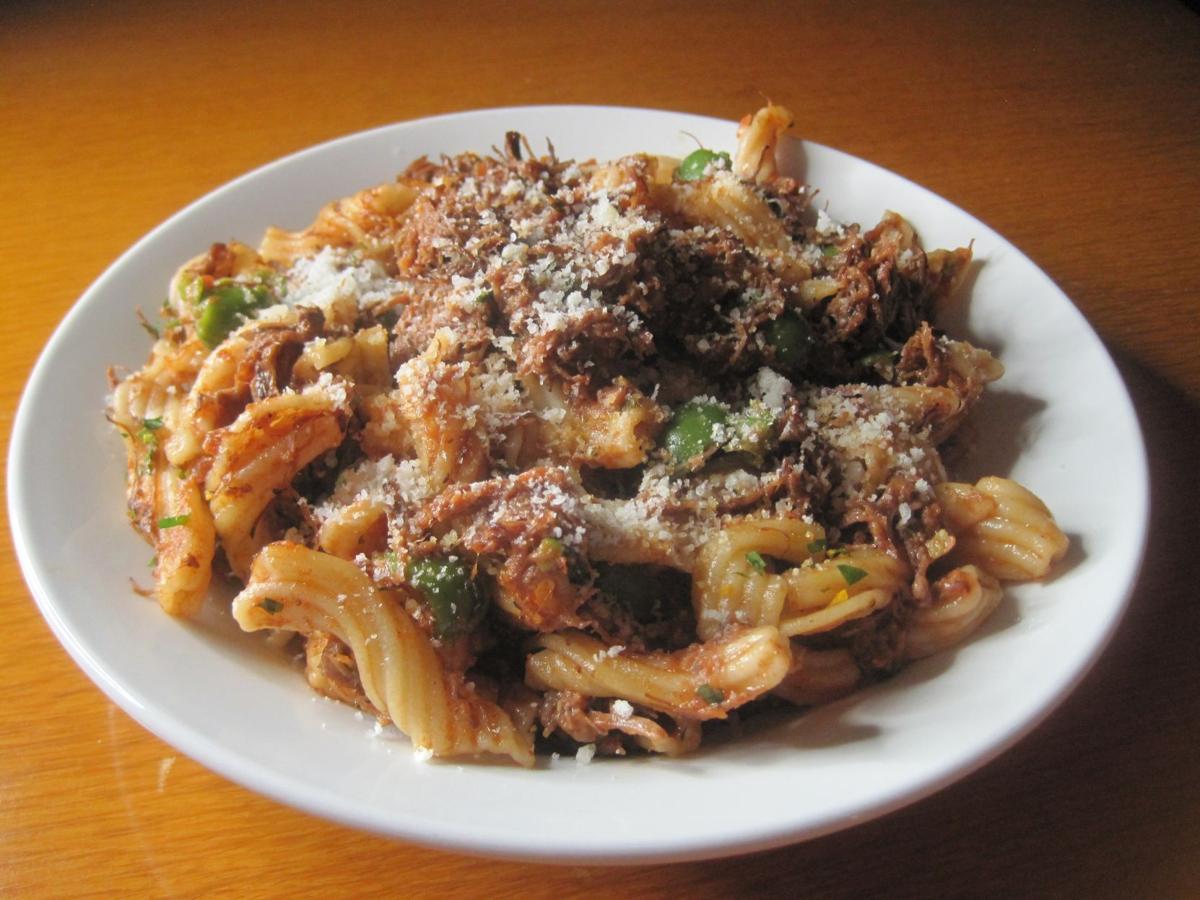
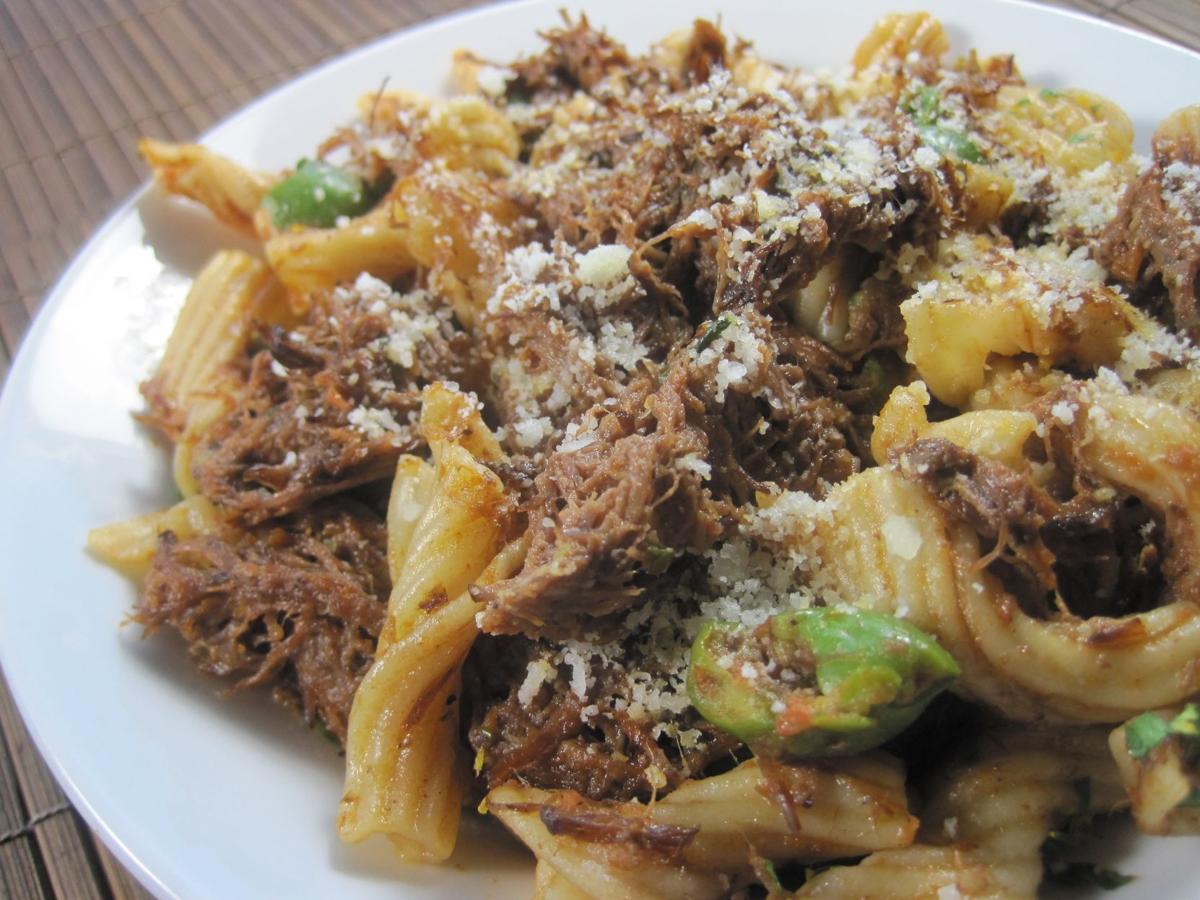
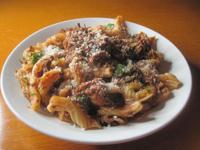

Hanya di DEWALOTTO BO terpercaya permainan terlengkap dengan proses tercepat dan pelayanan 24jam dari kami yang siap melayanin anda semua jadi tunggu apa lagi yuk segera bergabung..
ReplyDeleteADD WA +855 888765575 Terima Kasih admint...:)